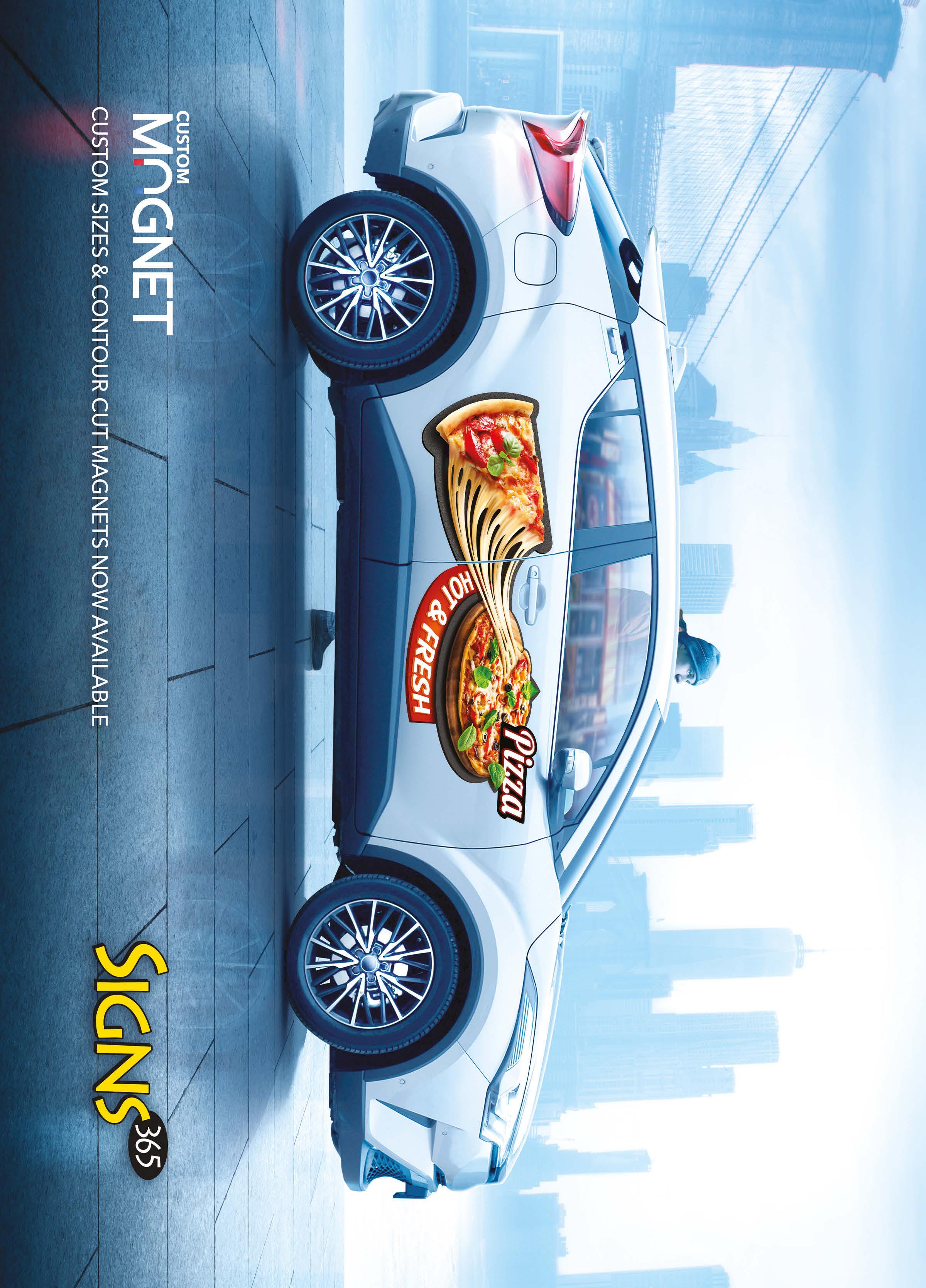Issue Five 2023 Labels & Packaging




president
Eric Vessels
Production Editor, content development
Amy Noble
Senior Editor
Cary Sherburne
account executive
Stephanie Papp





president
Eric Vessels
Production Editor, content development
Amy Noble
Senior Editor
Cary Sherburne
account executive
Stephanie Papp
CEO
Thayer Long
Chief Technology Officer
Adam Dewitz
production editor, multimedia Development
Jessica Taylor
Senior Editor
David Zwang
contributors
Kevin Abergel
Joanne Gore
Steve Johnson
subscriptions
Need to subscribe? Unsubscribe? Update your contact information? Do all those things here!
whattheythink.com/subscriptions
What not to do: Email. Send a letter. Call. Knock on Adam’s door.
Ralf Schlözer
Sean Smyth
Heidi Tolliver-Walker
other stuff
Questions?
Comments?
Senior Vice president, content & programs
Julie Shaffer
Managing Editor
Richard Romano
client engagement & project coordinator
Debbie Papineau
account executive
Adam Goldman
High fives because we’re awesome?
whattheythink.com/hello
What not to do: Smoke signals. It’s bad for the climate.
WhatTheyThink is the global printing industry’s go-to information source with both print and digital offerings, including WhatTheyThink.com, WhatTheyThink Email Newsletters, and the WhatTheyThink magazine. Our mission is to inform, educate, and inspire the industry. We provide cogent news and analysis about trends, technologies, operations, and events in all the markets that comprise today’s printing and sign industries including commercial, in-plant, mailing, finishing, sign, display, textile, industrial, finishing, labels, packaging, marketing technology, software and workflow.
WhatTheyThink (ISSN 2642-3189) (USPS 500-850) Volume 46, Number 5 is published six times per year in January/February, March/April, May/June, July/August, September/October, November/December by WTT Media, Inc., at 2038 Ford Parkway #218, Saint Paul, MN 55116. Periodicals postage paid at Saint Paul, MN and additional mailing offices. POSTMASTER: Send address changes to WhatTheyThink, 2038 Ford Parkway #218, Saint Paul, MN 55116. Subscriptions: Individual subscriptions are available without charge in the U.S. to qualified subscribers. Publisher reserves the right to reject non-qualified subscriptions. Annual subscription prices in the U.S.A $95; Canada $125 USD; all other countries $150 USD. Printed in the USA. Copyright © 2020 WTT Media, Inc. All rights reserved. No part of this publication may be reproduced or transmitted in any form or by any means, electronic or mechanical, including photocopy, recordings or any information storage or retrieval system, without permission. WTT Media Inc. does not assume and hereby disclaims any liability to any person or company for any loss or damage caused by errors or omissions in the material herein, regardless of causation. The views and opinions in the articles herein are not those of the publishers, unless indicated. The publishers do not warrant, either expressly or by implication, the factual accuracy of the articles herein, or of any views or opinions offered by the authors of said articles.
Welcome to the Labels & Packaging Issue.
Labels and packaging represent perhaps the largest growth area in today’s printing industry, and study after study has shown that the potential for growth in digital packaging is substantial. For example, Smithers has found that the global printed packaging and label sector is a market worth $517.7 billion this year, and it will grow at an average CAGR of 3.0%, with digital printing significantly ahead of the analog segments.
PRINTING United Expo and drupa are on the horizon, so there is a lot of development going on with packaging press and converting machine manufacturers to address the new shifting market requirements, and David Zwang takes a look at the latest developments, and how the printing and converting processes can align.
David also looks at the current state of the emerging “web-to-pack”—a packaging-centric iteration of web-to-print that offers myriad opportunities yet great complexity in the world of online consumerism.
Heidi Tolliver-Walker looks at consumer attitudes regarding packaging sustainability. Consumers want more sustainable packaging—but at what price?
Our Tales from the Database series looks at how respondents to WhatTheyThink’s annual “Print Business Outlook Survey” have seen labels and packaging as a new business opportunity and the extent to which they are investing in label and packaging printing technologies.
Digital embellishment maven Kevin Abergel looks at how embellishments on consumer and retail packaging and labels can be key differentiators for brands in a highly competitive consumer market.
Ralf Schlözer provides a primer on embellishments for packaging, and presents some highlights from Taktiful/WhatTheyThink’s landmark Specialty Inks and Toners Study.
Joanne Gore explains how print providers can capitalize on labels and packaging to generate new revenue streams.
Sean Smyth looks into the box his crystal ball came in and offers a peek at what the future of packaging holds.
We also feature an Executive Q&A with Lisa DiGate from issue sponsor Michelman, a provider of innovative specialty coating solutions for the labels and packaging market. Find out how Michelman is “Innovating a Sustainable Future.”

Going beyond packaging, Cary Sherburne offers a reality check on the reshoring of textiles and apparel production.
So, without further ado, we present the Labels & Packaging Issue.




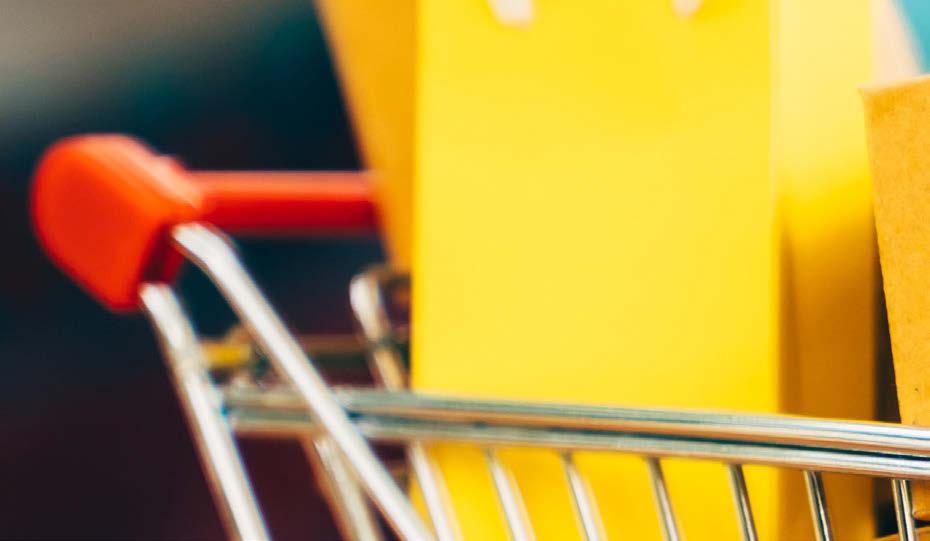





Make the move to digital – and unbox your business with the power of just-in-time jobs, fast-cycle proofs and prototypes, and customized campaigns.
With the new EFITM Nozomi 14000 LED digital press for corrugated packaging and POS, you can offer endless creative opportunities with VDP, white ink, and more. And personalise runs from one to infinity at higher margins and with lower costs – all in a single pass.


Let’s build your brilliant future. Together. Scan to learn how corrugated converters and packaging printers are opening up new opportunities.


Air-cooled UV Curing System
Fully air-cooled UV LED for printing, coating and converting applications
• Transform process reliability
• Simple design, consistent output
• Reduce energy costs by up to 70%

• Single fan: quiet, dependable operation
ArcLED compatible: easier LED upgrades

• Optimise your press with a mixture of Arc and LED curing on any station, for the ultimate flexibility.
Interchangeable UV curing systems
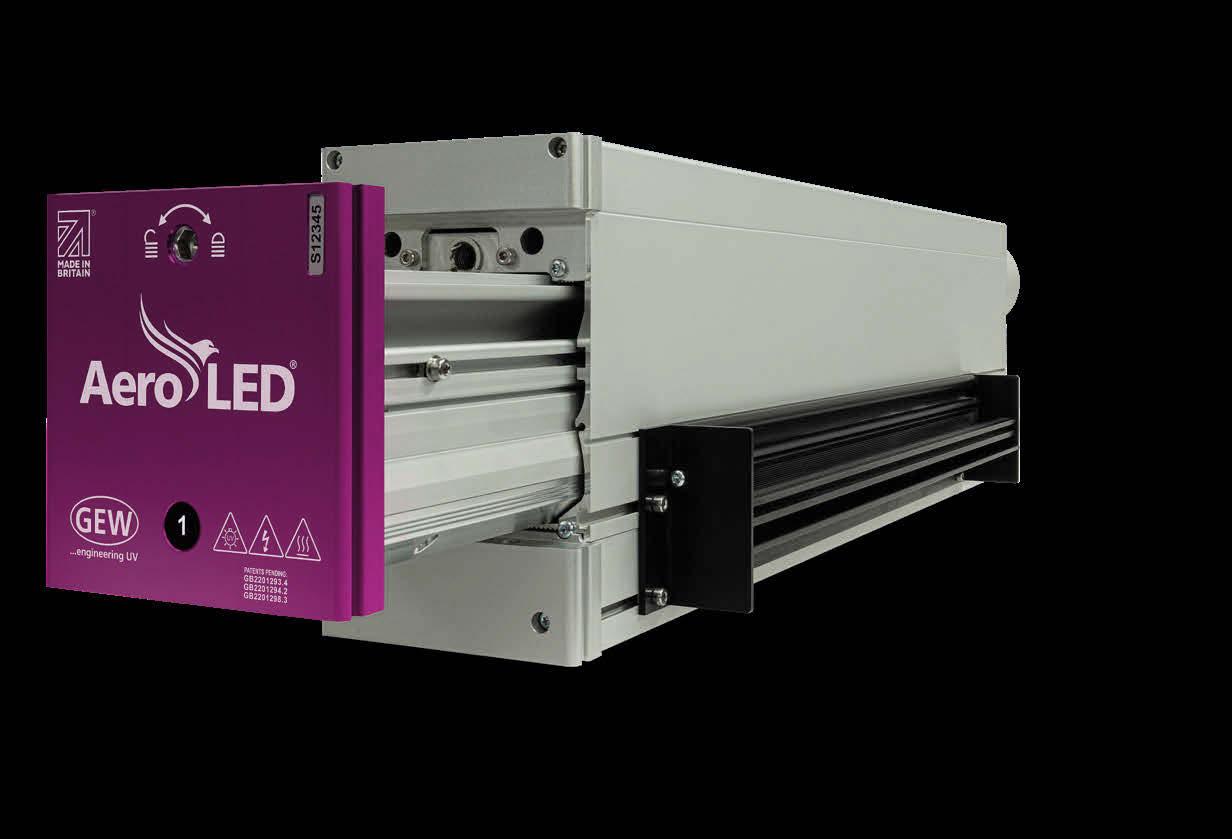
Find out more about AeroLED here:

 By Heidi Tolliver-Walker
By Heidi Tolliver-Walker
As consumers’ preference for sustainable products grows, that preference is extending to the packaging those products come in. A growing number of studies have been conducted on this topic, ranging from consumers’ attitudes toward sustainable packaging overall to their perception of single-use plastics, specifically.
A 2020 global survey by Boston Consulting Group found that 59% of consumers are less likely to buy products in packaging harmful to the environment, and 47% won’t purchase products in harmful packaging. Nearly three out of four are willing to pay more for sustainable packaging. These findings are consistent with other studies of this type.
Who do consumers blame for the world’s environmental problems? Brands. According to research commissioned by Footprint, 85% said brands should play a major role in solving the world’s climate crisis, because they’re the ones causing it. A majority (78%) said that companies and brands are not currently doing enough.
Take fast food packaging as an example. Seventy-two percent dislike the amount of plastic food packaging waste they end up with at home. Eighty percent say takeout restaurants need to act faster
to get rid of plastic packaging and utensils. Eighty percent say grocery stores should do more to reduce the amount of plastic packaging being sold.
However, does environmental concern translate into action? One of the most wide ranging studies on this issue, “Sustainability in Packaging: Inside the Minds of U.S. Consumers” from McKinsey & Company, finds that the answer is, “sometimes.”
According to McKinsey, 52% of U.S. consumers report being “highly concerned” about the environmental impact of packaging. However, when push comes to shove, they rank overall sustainability relatively low as a buying criterion. When compared to other criteria, such as food safety, shelf life and ease of use, environmental impact comes in dead last.
One of the big tests of commitment to sustainable products and packaging is whether consumers are willing to pay more for them. McKinsey finds yes, in theory. But there are caveats.
Consumers want a wider range of options, and environmentally friendly products and packaging must be better labeled so they know what they are. More than one-third say they would buy additional sustainably packaged products if they were more available.
These caveats assumed, 60% to 70% of consumers (across all demographic segments) say they would pay more for sustainable packaging, but the study does not say how much is “more.”
Boston Consulting found that 25% of shoppers said they would pay at least 10% more, but not surprisingly, 52% of McKinsey respondents said they are more likely to buy products with sustainable packaging if they have to pay any more at all.
When asked what they want to see going forward, consumers—perhaps ironically—are looking to plastic. In fact, they are almost equally interested in recyclable and recycled plastic packaging and fiber-based substitutes. They also want to see more compostable packaging.
What are the types of packaging to see the greatest shift in preference going forward? Fully recyclable plastic bottles and containers, fully recyclable plastic films and compostable plastic films. Interestingly, the percentage of consumers who want to see more paper-based substrates going forward drops sharply, potentially due to concerns about deforestation (whether founded or not).

These findings are consistent with the changes consumers are already making at home. When asked
about their sustainable habits, Footprint found that consumers are most likely to say that, on a monthly basis, they take straightforward steps such as recycling (89%), avoiding single-use plastic (72%), and refusing plastic bags while shopping (70%).
Here are some other fun facts. Eighty percent like the idea of a plastic-free shopping aisle. Eighty-three percent like the idea of a sustainable or plastic-free search option for online grocery shopping. Eighty-five percent support sustainable/plastic-free packaging options for takeout. Fifty-three percent prefer to shop for their groceries online because it’s easier to tell if a product comes in sustainable packaging.
Many research organizations argue that sustainable packaging is no longer a “nice to have.” It is a “must have.” However, these studies find that for shoppers to take action, and for sustainable packaging to be a true differentiator between products, these actions must be painless. It must be obvious that the packaging is sustainable. Consumers want to have options, and there must be little to no additional cost. In other words, consumers want to have their environmental cake and eat it, too.
For years, industry analysts and other pundit types have identified opportunities for commercial printers in packaging printing, especially digitally printed packaging. But have printers themselves seen opportunities in these applications?
Drawing on seven years worth of “Print Business Outlook” surveys, our “Tales from the Database” series looks at historical data to see if we can glean any particular hardware, software or business trends. This issue, we turn our attention to labels and packaging.
These surveys form the basis of our annual “Printing Outlook” reports, the most recent of which (2023) is available through our website.
In every survey, we ask a broad cross-section of print businesses about business conditions, busi-
ness challenges, new business opportunities and planned investments. In our “Business Outlook” reports, we tend to focus on the most recent survey data, occasionally looking back a survey or two to see how these items have changed in the short term. Plumbing the depths of our survey database can give us a better sense of how these trends have changed since the mid-2010s.
If we take a look back into our database of “Print Business Outlook” survey results, we note that adding packaging printing capabilities has not been seen as a massive opportunity, peaking at 13% in fall 2021, but generally hovering in the single digits. Digital label printing is a bit lower, averaging around 5% of all print businesses since we added it in our fall 2017 survey.

Source: WhatTheyThink “Printing Outlook” surveys, 2016–2022
Source: WhatTheyThink “Printing Outlook” surveys, 2016–2022
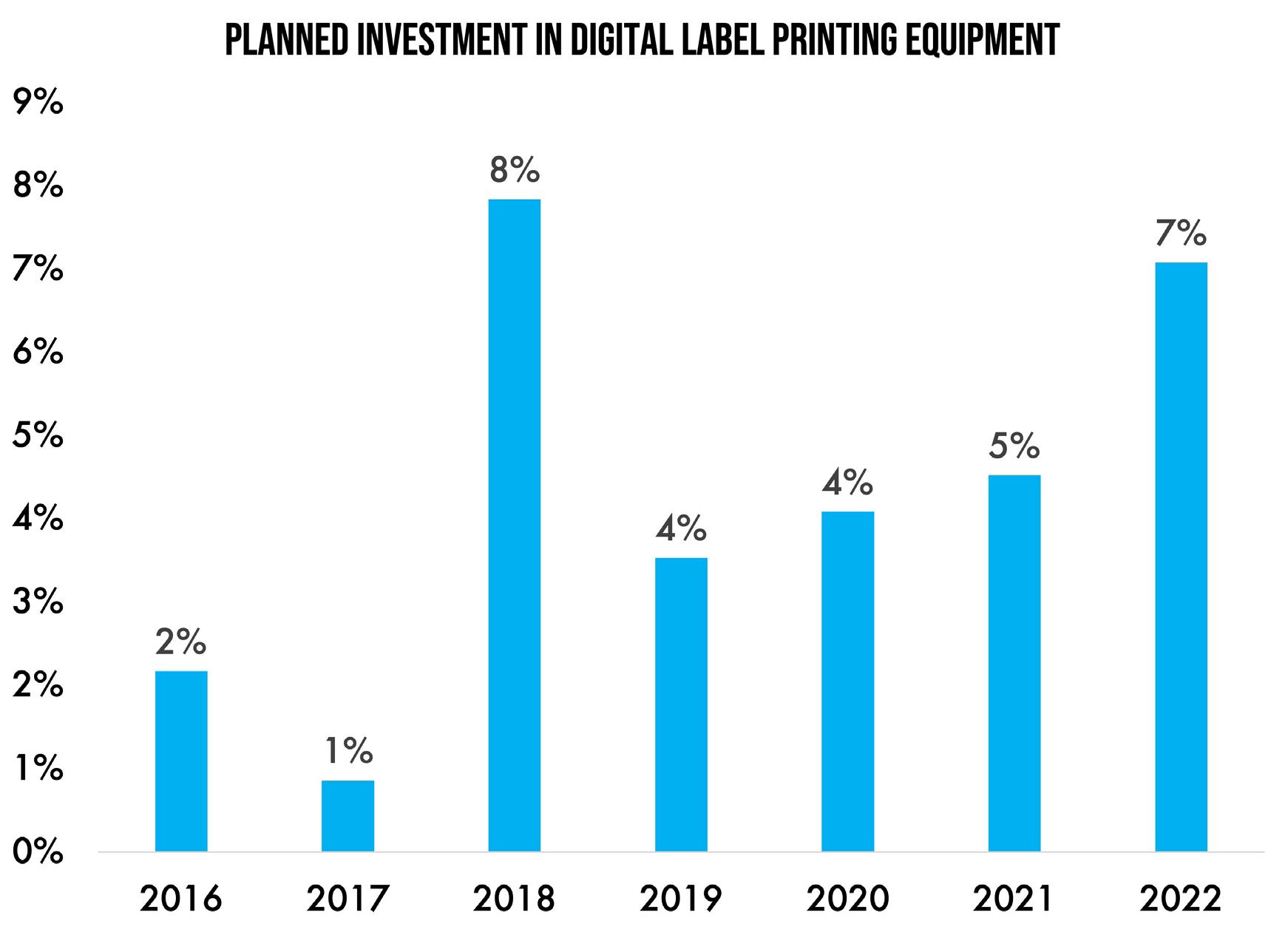
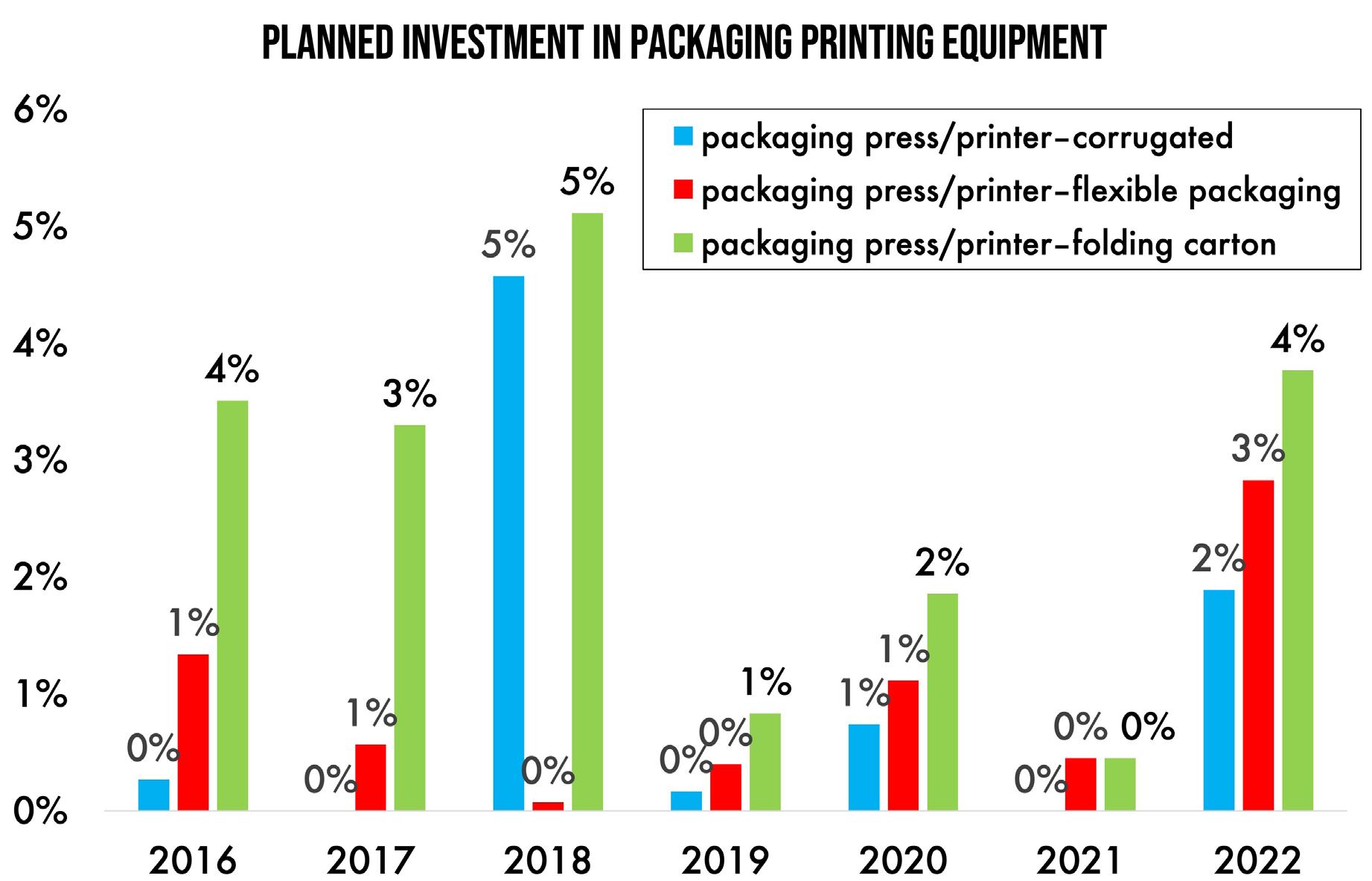
We also ask about the extent to which they are investing in equipment to produce these applications. In terms of packaging printing equipment (see Figure 2), folding carton capabilities have had the most appeal, although planned investment only averaged around 4% over the past seven years. Investment in flexible packaging and corrugated printing equipment have both averaged about 1% over the past seven years. All three printing equipment categories were up in our most recent survey. As the equipment—especially on the digital side—becomes more affordable and the market(s) become easier to enter, we may see some or all of these categories start to increase. Elsewhere in our surveys, we have seen that printers are looking at new areas in which to expand. Since most expanded into wide format/display graphics years ago, some form of packaging is a likely candidate.
On the label printing side (see Figure 3), planned investment has been a little higher than packaging, averaging about 4% of commercial printers over the past seven years. Investment has tracked fairly closely with perceived opportunity, so we suspect that printers are more sure of an expansion into label printing than packaging in general.
We also occasionally ask about specific expansion plans, and in fall 2020 we asked about the extent to which they had already added—or planned to add— various packaging printing capabilities (see Figure 4). A modest number of printers have already added these capabilities, with an even more modest number looking to add them in the next 18 to 24 months.

Generally, about two-thirds of print businesses have no plans to add packaging printing, although 13% to 15% will outsource it, which doesn’t preclude them adding these capabilities in-house at some point in the future.
In some ways, packaging today is where wide format was a decade ago: an appealing prospect but with significant barriers to entry—and poised to take off as those barriers are lowered. What will the remainder of the decade bring? Stay tuned…

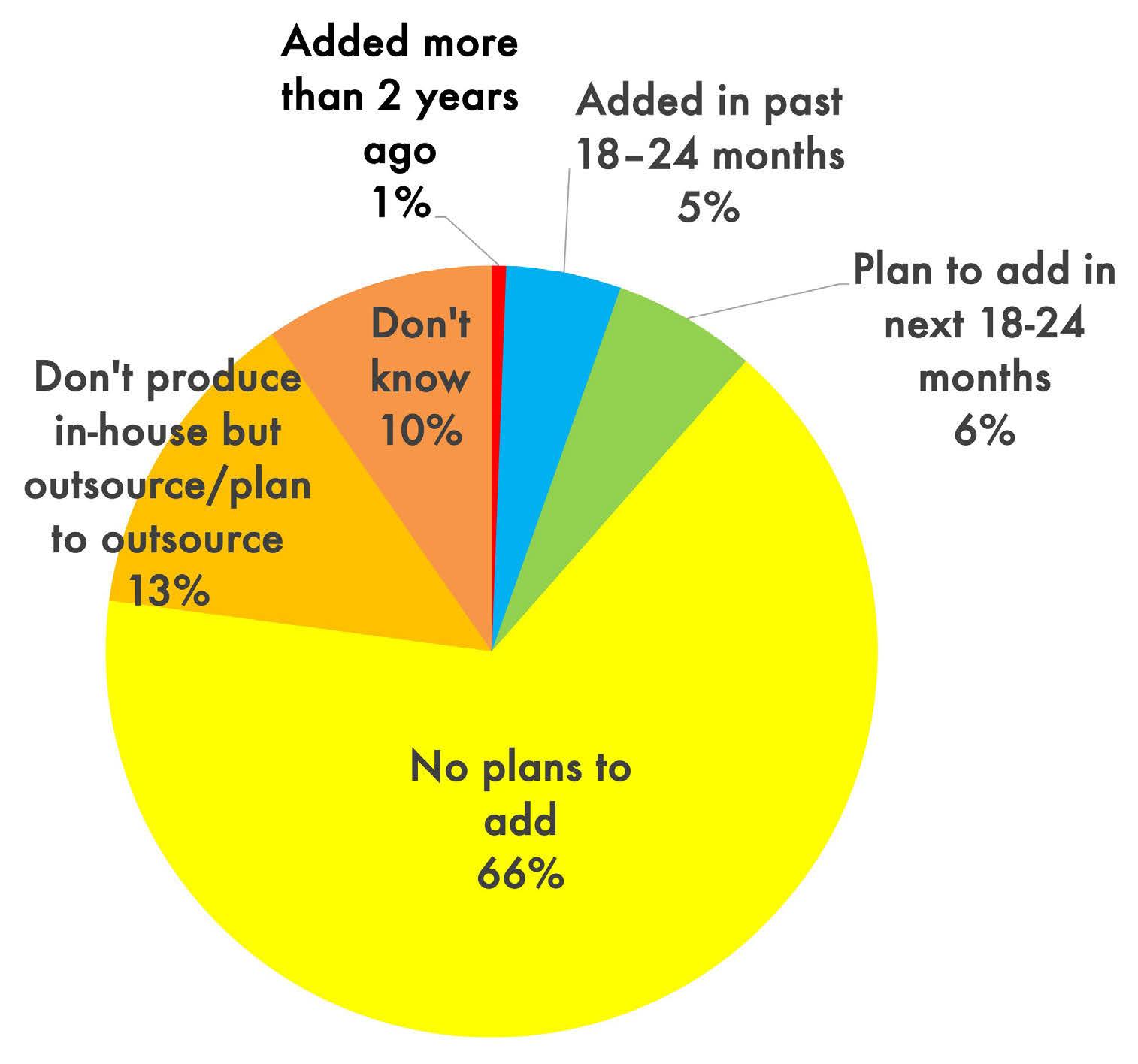
The Rapida 106 X maximizes your capacity for the highest productivity for every market segment. Industry-leading technology ensures the fastest throughput for more sellable sheets on your floor – day in and day out! Print at up to 20,000 sheets per hour - even in perfecting. The ultimate in color and quality control, simultaneous makeready processes and proactive digital services are among the benefits which help you always surpass your goals.
Rapida 106 X. The new performance benchmark in industrial printing.
rapida106x.koenig-bauer.com






Orders are increasing for short-run, on-demand packaging to satisfy shifting consumer purchasing requirements. While converters and webto-pack systems are being developed to operate at the “speed of retail,” there are many opportunities, complexities and value-added offerings not seen in commercial print.
According to U.S. Census Bureau data (https:// www.census.gov/retail/mrts/www/data/pdf/ec_ current.pdf), in the second quarter of 2022, e-commerce comprised 14.8% of total sales.
The “Global E-Commerce Packaging Market— Forecasts from 2022 to 2027” report further stated that “the global e-commerce packaging market is anticipated to develop at a CAGR of 15.87%, reaching a total market value of $98.856 billion by 2027, from $35.244 billion in 2020.”
While the pandemic had some “forced effect”
on purchasing for many reasons, according to a recent McKinsey & Company study, “The crisis has prompted a surge of new activities, with an astonishing 75% of U.S. consumers trying a new shopping behavior in response to economic pressures, store closings and changing priorities.”

Online purchasing frequency is determined by age, with the younger generations providing the largest share.
According to Internet Retailer, approximately 35% of consumers aged 18–39 shop online at least once per week. Compare that with about 45% of infrequent online shoppers (ages 40-64) who shop online at least once per year. More importantly, “global” digital sales are growing faster than the more saturated U.S. e-commerce market.
Ready-to-eat foods are projected to grow at a CAGR of 7.7% to $3.8 billion by 2032. It’s a perfect
Web-to-pack offers a myriad of opportunity and complexity in the world of online consumerism.
David Zwang
candidate for a nice package to replace a cellophane or paper bag and label in short runs, especially if the producer is looking to expand to more competitive online sales.
Another growth area is craft beer, which is projected to grow at a CAGR of 6.9% to $174.68 billion by 2032. Cannabis is projected to grow at a CAGR of 15.3% to $72 billion by 2030.
Web-to-pack offers a great solution to take advantage of all of these new demands in quick-toshelf packaging.
Many B2C (business to consumer) print service providers using web-to-print have found their product niche and try to stay out of the race to the bottom on pricing. However, an increasing percentage of printers—who have a structured and constrained print product need with limited variability—have found that B2B web-to-print implementations can provide a better way to engage and serve their customers. So to what extent can it work for packaging?

Some of the earliest entries into the web-to-print marketing category were “constrained design” template-based solutions that offered a print service provider a way to streamline the ordering of personalized business cards. These solutions grew from offering a variety of business cards to offering larger catalogs of products, which could include brochures and mailers. Vistaprint/Cimpress was and still is the poster child in this space.
Web-to-pack solutions have been following a similar trajectory in that they are usually, but not always, a constrained design solution, or a catalog of customized product offerings.
Chances are you have one or more cartons currently stacked outside your front door. It is a growing global phenomenon.
Corrugated, solid-fiber packaging and flexible packaging use are each projected to grow by about 13% between 2022 and 2027. Considering that the global population growth rate has declined from approximately 2% in the 1960s to 1.05% today, that means we are purchasing and consuming a lot more products. In fact, global retail sales are expected to increase at a CAGR of 7.7% through 2025 as a result of the growing middle-class consumer population.
There are many forms of packaging available today, and boxes play a role in almost all of them, whether directly for the product, product aggregation or transport.
That growth also includes all sizes and shapes of flexible packaging, both preprint and postprint
corrugated and carton production, an important distinction. That short-run growth will come from flexo, offset and digital, an important distinction to note, since many believe that only digital print is designed for short runs or on-demand applications.
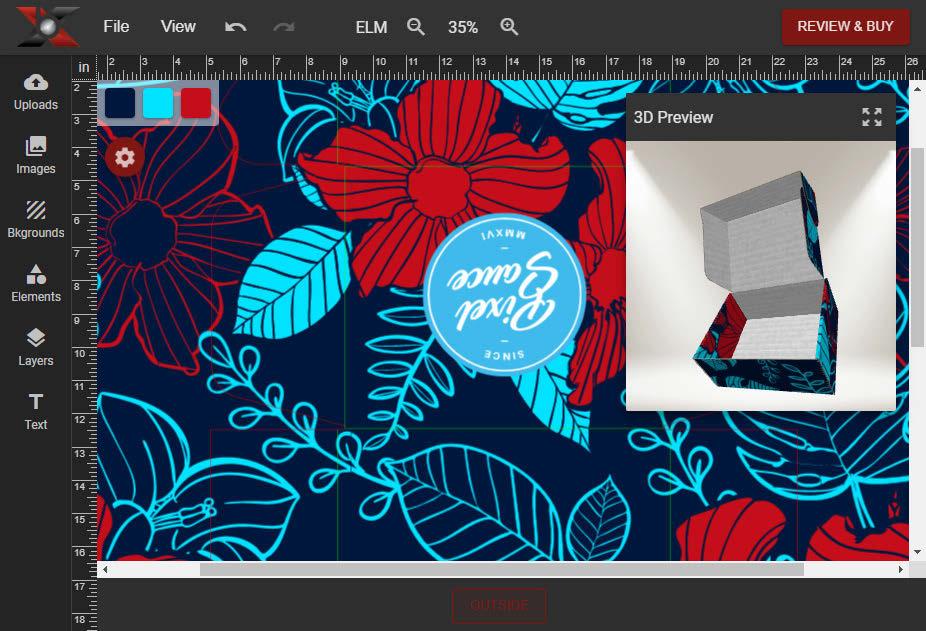
As the generational purchasing shifts take hold, the quest for more product variations, sizes, tailored messaging and promotions will continue to be key drivers behind SKU proliferation and more packaging. Much of that growth will be in the form of shorter runs and quicker turnaround.
While the B2C and B2B models of implementation and constraints on variability still exist with packaging, converters are finding levels of complexity not seen in commercial print.
There is no single packaging application or type. Packaging types can include primary, which has direct contact with the product; secondary, which can group primary package components; and even tertiary.
There is also no single packaging format, as packaging can include labels, flexible packaging, paperboard boxes, corrugated boxes, as well as bottles and cans. Granted, with each of these, there could be web-to-pack software available, provided there is an understanding of the rules of limited variability.
Since the shift from large global brands to smaller local/regional brands is increasing, so is the amount of disparate packaging required. Think more targeted and shorter packaging production runs similar to what has happened in direct mail and marketing.
Smaller local/regional brands are usually more likely to engage local resources for their design and packaging needs. Global brands competing against smaller local brands will undoubtedly also have to adjust their current relationships with their global packaging resources to align with the supply chain management responsibilities at the local/regional level.
Web-to-pack or webshops are a growing part of the offering expansion for some commercial print PSPs. However, it is also growing in existing packaging converters.
Web-to-pack shops, both connected to converters or standalone, are acting as transaction engines for a wide range of digital and flexo printed products. They include solutions for labels, folding cartons and corrugated packaging, and are continuing to expand.
Unlike most web-to-print applications and print providers, ordering a box online can be a complex process. After all, a box can take many shapes and sizes, and if you are not a packaging engineer, how do you create the template, die outline and ultimately the graphics to fit?
Almost all web-to-pack solution providers have pattern templates for the outside of the box. Here is how one particular platform works.
To get started, you select a pattern for the outside of your box from the “Pattern Templates” menu. If you have your own design that you want to use on a product, you can download the layout template for your choice of design product.
Create your design, then upload it using the “Image” tab. You can then review the mockup with an interactive 3D visual of the package. If it’s a box, you can open and close the lid with a click, and rotate the box to see it from every angle.
Choose from different fonts and colors to add a text layer, and place the text anywhere you want. You can even design the interior if you want to provide an opening experience.
Once you’re finished, go to design review, grab the preview, and move it around to see how your box looks. If there’s anything you want to change, you can return to the design studio. They are preparing contextual how-to videos to help the customer. Ultimately, what they want to provide is a frictionless site experience.
Vistaprint, one of the early web-to-print providers, now has a line of product packaging offerings comprising everything you need to package your
product. This includes labels, flexible packaging, folding cartons and shipping packaging, which are basically corrugated boxes that you can customize. They also have gifting and accessories.
Vistaprint has found that customers will probably buy multiple products, so that company makes sure that they are sending or showing the relevant products for customers’ needs.
This includes the upsell. Customers may need other printed materials to support product packaging and sale. Since they are usually serving small- to medium-size businesses, they are building a “good, better, best” strategy.
So if the customer has a limited budget, and knows exactly what they need, they can select a particular price point, and the right products for them would be shown.
“Better” could include a finishing option or a little bit more premium quality substrate. The “best” option includes all the foil and the raised print and everything else that a customer would need to showcase their brand.
ePAC has led the way with on-demand flexible packaging, and their growth has been explosive. Since their first plant opening in 2016, they have expanded across North America and into Europe, Asia and Africa. They currently have 26 manufacturing facilities and are still growing.
They are an all-digital on-demand flexible packaging company that could not find any off-the-shelf webshop solution to satisfy their requirements.
“We have not found a web storefront software that fits the needs of the digital flexible packaging market,” said Carl Joachim, ePAC co-founder. “The goal is to have a UI that is superior and also addresses the needs of the flexible packaging marketplace. We don’t believe there is anything out in the market that could satisfy our needs, due to the changing nature of print procurement and production automation.”
As a result, the company is in the process of developing their own front-end web storefront. In addition, the company is laying the groundwork for integration into PrintVIS, the company’s MIS solution.
One of the new value-added services they offer is Connected Packaging, where they can apply an individual QR code to a package, which can be used to engage the end consumer and provide other valuable market information to the product manufacturer.

Giuseppe Priorie is the founder of Pakly, a unique web-to-pack company located in the province of Campobasso, Italy, near Naples. He decided to build his own web-to-pack business and systems.
Since carton manufacturing was new to him, like many commercial print service providers that take that first leap into packaging, he reached out to Aviv Ratzman, the founder of Highcon, for some initial guidance. He started to develop his online transaction software in 2014 and launched the initial build in 2015.
The software walks the customer through box creation based on size requirements and then produces a die outline and a 2D and 3D preview of the box. He approached HP in 2018 after seeing the HP 20000, and asked if they could build one he could use for folding carton work. That became Pakly’s first Indigo 90K. They also have three Highcon laser die cutters.
He also licenses the software to converters around the globe, who want to enter the web-topack market.
The prospects of web-to-pack viability vary by market and application, just as they do with web-toprint. Constrained design packaging products that include a library of label or package types are the way most of the successful solutions are developed.
Each of these solutions provide display templates. They are on-demand, web-to-pack converters that developed their own software. Basically, customers fill out the order form, upload imagery, and visualize the finished product with a 3D viewer.
Ultimately, the success of these implementations, as it is in web-to-print, is by limiting the variability of the design and production offerings. Of course, having the production plant automated in order to integrate these solutions is really the first step. Also important is understanding that B2B will offer fewer challenges than B2C.
Box It Now developed an online custom box creation software tool, but unlike Pakly, isn’t a converter. Kerry Drake, VP of sales and marketing for PXI Digital solutions, the creator of Box It Now, came from the packaging industry. He describes the software as a “collaborative web application, primarily used for new packaging development in the consumer product development cycle.”
It is available to consumer product companies as well as printers and converters through a monthly subscription. It is available as an e-commerce widget for easy integration into a website.
Most of the packaged web-to-pack software solutions on the market today operate in a similar fashion and include standard templates. While some solutions are licensed, some are subscription-based.
PrintNow’s solution supports over 300 parametric standards for both paperboard and corrugated boxes. They also offer many configurable controls over the way the application works, and have an enterprise API for integration with existing business and production systems.

Infigo software provides a toolkit to build a web-to-pack solution for labels, flexible packaging and folding cartons.
Having an MIS system that supports all of these web-to-pack product distinctions is also a good idea. Tharstern, now a part of ePS, has been developed to support those needs.
ePS Packaging software is built to enable customers to design and order folding carton products online. With stunningly realistic 3D renderings, customers can create and design 3D packages—applying their own graphics and artwork while previewing and approving the job. The production files can be supplied as ready-to-produce files containing all the necessary high-resolution artwork and die files required.
Design ’N’ Buy offers a web-to-print and webto-pack solution that can integrate and automate the online experience. It is offered as a lifetime license or as a monthly subscription.
Packaging design will always play a critical role in engaging the consumer and establishing and reinforcing brand recognition and loyalty. However, the amount and—more importantly—the accuracy and consistency of the content is becoming more critical.
One of the biggest challenges is maintaining identical content across the product and marketing applications. If you are an independent product manufacturer or a converter that supplies them with packaging, there are potential pitfalls that need to be monitored and resolved. As design and production workflows continue to expand beyond a single controlled process to more disparate and distributed processes, and as global packaging regulations increase, they demand a better solution.
Depending on the product, it is important to comply with regulatory provisions. The Drug Supply Chain Security Act (DSCSA) was enacted by the U.S. Congress on Nov. 27, 2013. It requires that there is an ability to track and trace all products in the pharmaceutical distribution supply chain.
Similarly, the Food Safety Modernization Act (FSMA) has been proposed as a requirement for those who manufacture, process, pack or hold foods on the Food Traceability List (FTL).
Each of these add not just a need to ensure accurate and consistent packaging and marketing content, but also a potential liability. With brand identity, regulations and need for further integra-
tion into the value chain, it is critical that a solution supports compliances. Those could include the maintenance of consistent information across all uses, but it could extend to other areas as well.
ManageArtworks has taken on that challenge with an end-to-end packaging artwork management system. It is a cloud-based collaboration platform that was designed to address the specific requirements of packaging and brand content management.
By capturing, managing and distributing the brand content for all its intended needs, it ensures accurate and consistent content use. For design, there is a plugin that talks directly to the system providing you with the latest version. If there is a change in the system, you see it in the plugin, click a button, and it updates the content.
Ultimately, the real goal is the time it takes to get the product “shelf ready.”
While most of these solutions have templates and guided workflows, structural packaging design complexities can be challenging for even an experienced designer, according to Ed Zumbiel of Zumbiel Packaging.
Zumbiel created a web-to-box solution to streamline their craft beer client growth. Between the structural complexities of design against the template, to more mundane problems with fonts and file formats, they found that the prepress department had to spend more time on these web-to-box jobs than their regular client jobs. Ultimately, they took the site down, and are onboarding jobs through CSRs, at least for now.
Other awareness complexities include those around safety, product ingredient labeling, track and tracing regulations, as well as anti-counterfeit measures, depending on the product and markets. Converters have expertise in these areas and can guide these small producers, according to Carl Joachim from ePAC, the largest on-demand global flexible packaging producer.
These are just a sampling of huge growth opportunities for web-to-pack and short-run, on-demand packaging. However, while there are opportunities, there are many complexities not seen in commercial print, that require a level of expertise not necessarily found in the producer’s kitchen, basement, or garage. In fact, many of these complexities require an experienced converter or designer to navigate.
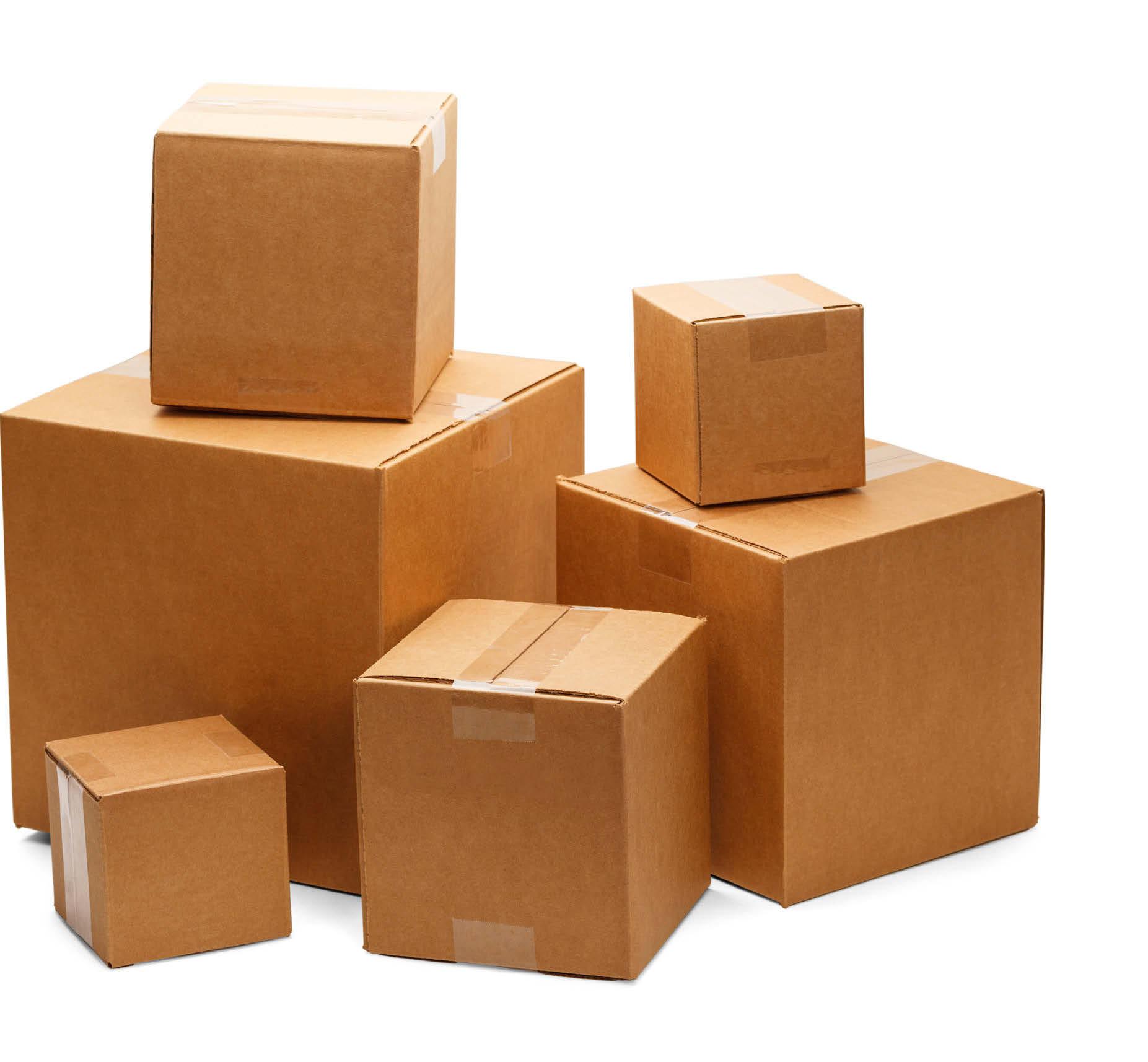




If you have ever been to a Pack Expo, once the printing is done, whether it is a label, flexible package or folding carton, it needs to be integrated with some finishing and converting, then delivered to the application for which it was designed. Each of those applications requires different types of equipment. That means that the print and the converting processes need to align.
While there aren’t a lot of all-in-one application-specific solutions that can address all of them yet, with PRINTING United Expo and drupa coming up, there is a lot of development going on with packaging press and converting machine manufacturers to address the new shifting market requirements. Ultimately, application requirements can be fairly disparate, so a modular hybrid solution will undoubtedly provide widest range of process adaptability.
Analog press and finishing equipment provided us with the one-solution-fits-all design, where production is primarily confined to disconnected processing steps, except for some flexo applications. It continues to serve the printing industry well. However, as the market demands change, there is a need to think differently about print and packaging production.
Historically, most packaging production print has been fairly static, driven predominantly by flexography and offset, with gravure picking up some of the longer runs. The introduction of inkjet enables the imaging engine to decouple from the “standard” transport, and in its place become part of a custom or bespoke transport solution.
As a result, we are just beginning to see the creative opportunities that can be achieved. However, packaging is a lot more than printing.
We have seen the de velopment of many inline modular solutions that go from white or brown paper (either cutsheet or roll) to finished product, including embellishment. These connected hybrid solutions have stream lined print production and enabled a whole new gen eration of digital printers to enter the industry.
Flexography continues to reinvent itself, resulting in extremely high-quality print while still providing high productivity and low cost, which creates a significant defense against electrophotographic and production inkjet solutions.
While the basic concepts of flexography have not changed, digital enhancements are affecting everything, from transport to imaging, and providing significantly enhanced automation and control.
In the area of transport, the use of visual and other sensing technologies, combined with digital servo controls, enable less operator involvement and better control. This provides an advantage for flexo in that it can also be configured to address a full production line from precoat (if needed) through printing, embellishment and finishing.
That being said, all-in-one flexo solutions have been evolving as well. Expanding from the initial roll-to-roll design to more complete solutions, they can now include inkjet printing, die cutting and embellishment. Two good examples of that are the Bobst Digital Master Series and the Gallus One.
The Bobst Digital Master Series are built on Bobst’s modular and upgradable M5 flexo platform in combination with the Bobst Mouvent Clus-

Print and packaging can live in perfect harmony.
By David Zwang
ter inkjet technology. These presses are designed to produce label, shrink sleeve, flexible packaging in more narrow- and mid-width applications.
The Gallus One digital label press is more than just an all-in-one label press, similar to the Bobst solution. It is also designed as the base for an expandable solution, not just a standalone print engine. One could say this is only the beginning as this new modular platform can spawn several variations in the future.
Initially, Heidelberg’s new Gallus One was promoted as an all-in-one press. However, the Gallus One DPU (Digital Print Unit) can also be used as a base for growth and/or an option to existing Gallus ECS flexo presses.
This solution can bring everything inline and features a digital printer with an inline flexo station, a semi-rotary die cutter that can change a job within one minute and process up to 70 m/ min., and vision inspection systems to ensure the highest level of quality and to minimize waste. There are many options that can be added, as the requirements may vary for each converter. The units can be reconfigured on-site as the need
arises, as a result of the flexibility of the Gallus rail system made popular on the Labelfire.
All-in-one presses are not exclusive to Bobst; others, like the Canon LabelStream 4000, OMET XJet platform integrating Durst’s Tau 330 digital inkjet system with OMET X6, Mark Andy Digital Series iQ, and many others have similar specifications.

Many of the earlier EP digital label presses are printing at 25–30 m/min., but now, with the increased speeds of the HP Indigo V12, we are seeing 120 m/min. and up for a digital EP label press. However, even operating at 120 m/min., many flexo presses can run at 300 m/min. and up, and adding the increased costs associated with running digital vs. pure flexo still presents issues for large volume runs.
So the reality for quite a while will be the coexistence of digital and inkjet with flexo based on volumes and cost. In the short- to mid-term, the battle lines are being drawn between EP and inkjet for capturing the shorter-run, on-demand label production along with inline finishing and embellishment.
This hybrid approach is not only for labels; we are seeing it now in folding carton, corrugated ad flexible packaging.
For example, the Heidelberg Boardmaster was designed for increased productivity and zero changeover downtime, with the Non-Stop Print Deck technology in conjunction with the Intellimatch scanning system.
The Boardmaster is highly flexible as a result of its modular design. Folding carton production varies based on the type of carton and the required finishing. Consequently, the Boardmaster is designed to be a part of the larger Heidelberg ecosystem.
Currently, the press can run roll-to-roll, roll-tosheet or roll-to-blank, and future plans call for the integration of various inline finishing features, such as lamination, hot- and coldfoil stamping and rotary screen printing. The Boardmaster can also be installed along with the Heidelberg FCL series flatbed die cutter. This machine can combine cutting, creasing, embossing and window and outer contour punching.
The Dantex Pico range of products have been designed on a modular platform, offering a wide range of inline finishing options: die-cutting, lamination, backlit/edge trim, slitting and rewinding. Their DecoTactile module is used to create a range of high-quality embellishments to give enhanced detail and vibrancy, such as raised tactile finishes and textures. High-build capabilities provide a digitally embossed luxury finish at low cost.
Inline flexo options offer a multitude of embellishments from spot- and flood-coat varnishing to spot colors and cold foiling. Self-wound and pre-wound laminates can be applied, as well as a full rotary die station, along with edge trim and slit modules.
Kento Hybrid is designed for corrugated packaging, utilizing a modular Celmacch HQ flexo press and an inline inkjet station. The feeder, flexo, primer and varnish modules are placed on rails for configuration flexibility. Integrated with this flexo press
is a single-pass solution that brings together the advantages of inkjet digital and high-quality flexographic printing, designed for corrugated cardboard.
As an enhancement to its printing capabilities, Kento offers the world’s first inline rotary die cutter on a digital printing machine, adding advantages in efficiency, speed and cost-effectiveness. It’s a true end-to-end print and die-cut solution.
As the market requirements evolve, many digital and inkjet equipment manufacturers are developing more flexible configurations to better address those requirements. A good example of that is the newly released HP Indigo V12 label press, which provides flexo performance in an all-digital press.
If we look at the MGI AlphaJET, also known as their “printing factory,” we can see modularity and flexibility that can be tailored to many packaging and commercial applications.
HP, EFI, Barbarán, Fujifilm, Xeikon, Domino, Hanaway and now Agfa—coming off the acquisition of Inca and their UK-based joint venture with BHS—are all competing in this market, and we can expect new developments from each of them to address the value vs. volume challenge of digital transition.
Some will say that, with skilled labor shortages, digital is still the way to go. However, if you look at the amount of digitalization and automation now available in these flexo hybrid presses, it begins to level the operational skill requirements. Inline automatic registration and pressure adjustments, automated maintenance and integrated semi- or full-rotary die options mitigate a lot of the legacy skill requirements.
As digital technologies advance and market requirements continue to shift, there will be continued growth in hybrid print solutions and most likely an explosion in bespoke machine development. I can’t wait to see what ingenuity exists out there, and what will turn up at drupa next year.
As the market requirements evolve, many digital and inkjet equipment manufacturers are developing more flexible configurations.


Michelman’s Lisa DiGate discusses the company’s latest technology in print and packaging.
We recently sat down with Lisa DiGate, vice president, global business–HP Indigo at Michelman, to discuss the power of innovation, collaboration and a focus on sustainability in propelling innovation forward in the digital printing and packaging industries.
Tell us about Michelman.
Lisa DiGate
At Michelman, we rally around one purpose: innovating a sustainable future. We feel both grateful and determined - grateful that our customers and our associates have helped us create a strong company with global manufacturing capabilities and a broad portfolio of unique water-based specialty coating solutions.
These solutions range from primers and overprint varnishes that drive growth in digital printing, to functional coatings for sustainable packaging, to unique solutions that protect seeds in the agriculture industry, and that enhance the production
of advanced composites for automotive and aerospace as well as the construction industry.
We are determined as a team to take these capabilities and solutions and continue to make a difference, as we have been, globally, for the past 70+ years.
Can you explain how Michelman’s coatings impart critical functionality in packaging and other printing applications?
There are multiple ways that our coatings provide needed performance in digital printing—including enabling printing on a wide variety of substrates, protecting printed surfaces and providing enhanced barrier properties in packaging.
For example, our DigiPrime® primers provide outstanding print receptivity on multiple substrates, excellent ink adhesion, food compliant options and options for use in compostable packaging. With broad substrate compatibility, these primers also support printing on renewably sourced and recyclable substrates.
It’s important to keep in mind that our coatings are part of total solutions. They work together with other materials to enable desired outcomes in final structures. These final structures are subjected to all sorts of environmental conditions. I’m not sure most consumers consider the number of environmental stresses that a package experiences between its point of manufacture, its supply chain journey and its appearance on a retail shelf.
At Michelman, it’s our job to think through to the end uses of our products and, working closely with our customers, develop needed solutions to protect, for example, the printed surface of labels.
A bottle of beer may encounter many environmental stresses after leaving the bottling line until it is in the hands of a thirsty consumer. These changes include variations in temperature and humidity, as well as “rubbing” challenges.
For example, the labels on beer bottles face abrasion as they rub against one another, or against secondary packaging, during transit. Our line of overprint varnishes and strengtheners help protect printed label surfaces from abrasion, UV
light and water. Using overprint varnishes helps maintain the eye-catching label graphics that can be a strong part of brand identity.
How do Michelman solutions help packaging manufacturers achieve their sustainability goals?

Our solutions support a circular economy in multiple ways. The megatrends of increased need for sustainability and customization have definitely been drivers in our focus on developing solutions that enable recyclability, repulpability and compostability. Our solutions enable the creation of packaging structures that are compatible with existing recycling streams; they help brands transition packaging from multi-material to mono-material and, sometimes, from film to paper substrates. Our solutions also enable the production of packaging that is lighter in weight and/or compostable—all while delivering the functionality required by specific packaging applications.
Michelman’s coatings, used for both flexible and rigid packaging, provide critical functionality such as water, oil and grease resistance; oxygen and moisture vapor transmission control; and heat seal directly to paper and film substrates. Developing final structures that are up to the task of providing necessary barrier properties, have good end-of-life options, and continue to meet or exceed demanding performance, regulatory and food contact requirements is quite challenging. This is why we collaborate closely with customers and other industry leaders to develop our solutions.
In the take-out food industry, we have worked very closely with a converter and a global coffee brand to develop a paper cup that can withstand environmental stresses associated with hot beverage temperatures and varying beverage chemistry. Most people may not know how adding milk, creamer, syrup, sugar or artificial sweeteners can impact a beverage, but each addition will change the chemistry of the hot drink. And each change to the composition of the beverage introduces additional performance challenges for the hot cup. Our current solution supports a transition to a recyclable paper cup and has no impact on the taste of the coffee.
Michelman plays a significant role in the digital printing industry. Tell us more about how this began.
Michelman began working with HP Indigo nearly two decades ago. During our nearly 20year collaboration, we’ve worked hand-in-hand with HP Indigo’s R&D, marketing and business support teams to apply our innovation and formulation expertise. New coatings are designed to specifically work with HP Indigo hardware, ink and
consumables—optimizing performance across a wide range of applications in digital printing.
Michelman has created a global channel network that allows us to service our primer customers with fast and reliable service. We also reach out to press owners for ongoing feedback to ensure that our solutions are delivering top performance—both from a production standpoint as well as providing the functionality needed in the finished product.
As noted above, “Innovating a Sustainable Future” is your purpose. Can you provide any examples of recent innovation and how that has benefited the digital printing industry?
Our latest innovation in the digital printing industry is DigiPrime Vision, a family of groundbreaking water-based digital print primers specifically formulated for use in the in-line priming units of HP Indigo Digital Presses.
We are really excited to launch DigiPrime Vision 9000, the first product of this new family. DigiPrime Vision 9000 enables printing on a broad range of challenging substrates. Consumers have grown accustomed to eye-catching labels and packaging that help products stand out from the crowd on retail shelves. What may seem like small changes in a label or package can have a big impact on the consumer experience. For example, some label makers might print on substrates where ink adhesion can be particularly difficult, including vinyl and heavily textured papers as well as niche materials like velvet, wood veneer and twill. HP Indigo Digital Press owners looking to expand into new applications, like these, will appreciate how DigiPrime Vision 9000 enables superior runnability.
DigiPrime Vision is also in the final development stages for the HP Indigo V12 Digital Press. Label pro-
This is a very exciting time to be a provider of water-based solutions that enable customers to take a leadership role in driving the circular economy.
ducers will be able to migrate longer runs from flexo to digital. It has great cross-platform compatibility and allows press owners to transfer jobs between the HP Indigo 6K, 8K and V12 Digital Presses. It also simplifies pressroom management while promoting performance, compatibility and ease of use.
WTT
How important is stakeholder collaboration in the development of innovative solutions for the digital printing industry?
If you are committed to a more sustainable future, you need to be committed to doing things that will help get you there faster and with greater effectiveness—our experience is that collaboration with partners who have the same values helps us get there faster.
We collaborate with partners in multiple ways, from joint development of packaging structures through engineering specific solutions to enable optimizing production efficiencies on HP Indigo Digital Presses. Our technologies enable new solutions and innovation. We often leverage our global applications experts to help customers identify solutions that will best meet their needs.
On the packaging end, we recently collaborated with other industry leaders to develop innovative technologies that facilitate improved end-of-life solutions for flexible packaging structures, including structures using either film- or fiber-based substrates. We developed a new generation of multifunctional oxygen primers that provides, in a single, thin coating layer, improved barrier properties while also aiding the metallization process. This collaboration resulted in development of two groundbreaking sustainable packaging solutions— including a recyclable metallized PE film structure and a paper-based packaging solution designed to replace high barrier film packaging.
We also share our stories of collaboration to help build momentum for change.
What lies ahead for Michelman?

This is a very exciting time to be a provider of water-based solutions that enable our customers to take a leadership role in driving the circular economy forward—this especially applies to our work in the digital printing, label and packaging industries.
Going back to our purpose of “Innovating a Sustainable Future,” we have long recognized the need to be good stewards of the planet. We continually challenge ourselves to develop new approaches to enable our customers, and our communities, to thrive. In the digital printing label and packaging industries, we help our customers expand what’s possible!
















Like many people, I work from home a lot more than before the pandemic. Knowing that someone is likely to be in, my children (who live nearby) used me as recipient for their online purchases.
They would come by and open the boxes and bags, taking their goods and leaving the packaging with us. This resulted in me fighting to squash the contents down in the recycling bin to make sure the lid can close, sometimes neatly stacking collapsed corrugated boxes beside the bin hoping the collection crew would take them. We still made regular visits to the local waste center, sorting the stuff into the correct bins.
I am sure many of you have had similar experiences, changing your consumer behavior in reaction to two megatrends shaping the future of packaging: sustainability and the growth of e-commerce.

Other trends include economics (which is ever present), the connected world further digitizing, and demographic changes.
While many western countries and Japan have aging, falling populations, the social changes give rise to more households with lower average occupancy. This drives packaging demand, while greater choice pushes demand for shorter runs. In other regions, populations are growing with the rise of the megacities as the world moves from agrarian to industrial economies, again driving packaging demand.
These trends result from the preferences and actions of millions of individual consumers alongside the availability of new technologies. These in turn push changes in local, national and regional legislation, reinforcing consumer behaviors that in turn drive new trends.
Smart brands and retailers are good at identifying these trends, and taking action to exploit the changing environments. How they specify and use packaging is firmly in the spotlight, impacting packaging converters who have to develop their production and go-to-market strategies to suit the
future needs of their customers, while also meeting the day-to-day demands of brands and retailers.
Economics are always important. The macro situation determines non-essential consumer expenditure, while pressure on microeconomics means a focus on each print run to achieve the lowest real cost.
The choice may be between long runs of lowunit cost or smaller runs at a higher unit cost to minimize inventory cost and the potential for obsolescence and redundancy.
For the brand or retailer, packaging is a direct cost. The global printed packaging and label sector is a market worth some $517.7 billion this year, according to Smithers, a leading research organization, and it will grow at an average CAGR of 3.0% in real terms (constant 2022 U.S. dollar values) with digital printing significantly ahead of the analog segments.

This huge market is less than half of the total packaging market. The large proportion of non-printed packaging reflects its key functions of protecting and containing products from manufacture, in distribution, at retail outlets and in use.
Printing the packaging adds information and promotion to these functions, avoiding a separate label. Using special inks enable physical “smart” functions and linking to the virtual world to provide new consumer engagement and logistic efficiencies.
Brands are exploring new functions to boost the experience of customers, making packs for the “Insta Generation.” These add more information and playfulness with competitions and promotions designed to develop direct contact and a relationship with their consumers.
Sustainability is on the agenda for many consumers. While Europe tends to lead the way, as the world records ever higher average temperatures and forest fires break out, the need for action is ever more apparent and urgent everywhere.
Consumers are placing responsibility on brands to meet legislative demands. Extended producer responsibility legislation makes pack producers cover the cost of recycling the packaging they place on the market, including collection, treatment and of course recycling.
There are other initiatives aimed to minimize packaging waste—many single-use plastics are being phased out, deposit schemes are being introduced in some countries, e-commerce void space is being reduced, and more collection and recycling points are being introduced.
So, what does this add up to, then? Flexibility and rapid speed to market are critical factors as demand forecasting becomes ever more difficult for brands and retailers. Changing consumer preferences are pushing recyclable and compostable substrates and printing. Buyers are demanding packs that will please their customers. It has to provide appropriate performance, at lowest unit and overall job cost, with minimum environmental impact and rapid delivery—all while meeting the legal requirement where it will be used. And innovative ways of reducing cost are being explored, so making the packaging do more can be very helpful.
Ghelfi Ondulati, in Italy, has run several campaigns on e-commerce boxes for Estée Lauder, which ships cosmetics direct-to-consumers in 120 countries. They identified the subscription box packaging as a new marketing channel to drive customers back to the company website, adding customized messaging on the inside of the box with a unique QR code used to track the efficacy of the campaigns.
They reported a 100% opening rate and much higher response rates than in direct mail, while reducing inventory, gaining supply chain flexibility and helping reach sustainability goals.
Amazon has run several campaigns on the outside of e-commerce boxes, advertising new film releases and TV programs on Amazon Prime.
Adding promotional messaging and advertising on packaging allows brands and retailers to change their packaging from purely a cost to a revenuegenerator. Most brands will not change their primary packaging to add an advert, but retailers certainly will if there is a commercial advantage.
One of the important impacts of the growing influence of digital printing is the response of analog press designers, greatly improving the connectivity and performance of the latest models. Digital print can do a lot more than just replace analog methods for short- to medium-runs. It helps to make supply chains more efficient, providing faster response and new opportunities. For e-commerce packaging, many brands are realizing the power of the unboxing experience to boost the levels of engagement with their customers.
This is a fantastic time for print technology, as manufacturers respond to the trends impacting packaging converters. Converters are seeing continuing falls in the average print run length, meaning they will have to handle a larger number of smaller jobs. This pushes focus on rapid changeover and set-up for print machinery, a key feature of digital presses, which are becoming more common in most packaging and label applications.
Modern offset and flexo presses and conversion machines are more efficient, automating many tasks to reduce makeready and run waste while producing more consistent results. Increasingly sophisticated digital workflows smooth design and prepress processes, part of the wider digitization of supply chains.
While digital print grabs most headlines, it is making analog far more efficient using software, robotics and automation.
In May, Swiss equipment leader Bobst bought Dücker Robotics to help fulfil its future vision of all production connected and more automated. Bobst announced improvements to both analog and digital presses, and there will be further announcements at Labelexpo in Brussels, open houses, the Fefco Technical Seminar and drupa next year.

Bobst is further developing their Accucheck system that is claimed to make zero-fault packaging a reality.
The “Recipe Management” feature allows users to remotely prepare and set up an inspection recipe based on the artwork file, and to save recipes and retrieve parameters, offering the beginning of the closedloop solution. This feature is already used successfully by customers to help reduce setup times while boosting quality.
The sophisticated inspection system is integrated into new print and converting equipment to check registration, color fidelity and print defects for every single pack. Unlike an experienced press operator, this system can check ev-
Estée Lauder versioned and personalized e-commerce boxes containing promotional messaging. (Source: Ghelfi Ondulati and HP)

ery impression, increasingly linked to automatic adjustments that repair any artifacts or deviations from the pass sheet. For sheetfed systems, faulty product is ejected automatically. On webfed systems, areas of concern can be marked for later removal. The technology will replace many manual quality inspections, pushing the potential for full lights-out automation with links across the supply chain to share real-time information with customers.
Bobst is also deploying an active strategy on sustainability, joining the “Science-Based Targets” initiative reflecting its commitment to urgent climate action. Bobst has formalized targets and is evaluating decarbonization options across all operational activities to reduce its carbon footprint.
Dario Urbinati, CEO of Gallus, highlights the labor shortages that are increasingly affecting label and packaging converters, alongside cost increases in substrates, ink, plates, energy and distribution. The company has rewritten its vision and mission statements to support a new business
direction, with inkjet narrow-web machines available for standalone printing and integration into existing flexo lines.
“We are excited to look beyond the graphic arts toward other industries,” Urbinati said, “learning from how they’ve leveraged new technologies to welcome in the new digital age and cater to the next generation—so that we can modernize the labels and packaging industry and further increase our future success.”
Gallus launched the standalone narrow-web inkjet press, the Gallus One, in June at their new Experience Center in St. Gallen, Switzerland.
One market niche they have identified is existing flexo customers adding digital print capability to existing presses, a much lower investment level than a new hybrid press.
“What we are doing is letting our customers upgrade their existing ECS 340 flexo presses with a DPU, effectively turning a conventional flexo machine into a Labelfire,” Urbinati said. “Adding

hybrid technology to their portfolio means a lower investment, because just buying the DPU for the existing conventional part reduces the investment cost significantly. We are providing a choice for our customers. The modular flexo stations can be removed or added, with cold foiling, screening, die-cutting and matrix removal as needed. This is an easy route to the well-proven and industrialized digital technology from the top peak performance machine Gallus Labelfire.”

There are many other providers selling hybrid narrow-web presses into the label market, and this trend is broadening into flexible packaging, cartons and now corrugated printing. These combinations allow greater flexibility than analogue systems with the benefits of full variability while using lower cost consumables.
I occasionally get asked the question: “Which technology should I use?” I always reply in the same way: “It depends …” which, apart from being true, allows me a bit of thinking time.
There usually isn’t a right or wrong answer, but getting it right and choosing the most appropriate technology to meet established market needs and satisfy new potential requirements is ever more important.
The choice is dependent on the markets a company serves, the business model and the strategy and existing capabilities of the converter. Across the globe, digital print is growing at a faster rate than analogue, because it can handle some of the short-term pressures of reducing cost with greater flexibility using less direct labor, while better meeting the longer term requirements of lower environmental impacts.
Label and packaging suppliers must react to short-term pressures while taking note of the long-term trends. I was always told companies should delight their customers. Now they need to delight their customers’ customers as well.
In the highly competitive consumer market where products vie for attention, packaging and labels can be key differentiators.
An effective strategy deployed by brands is the use of embellishments on consumer and retail packaging and labels. The aim is to give their products more shelf impact alongside competitors, but often also convey an impression of luxury and premium quality.

Metal foil effects, metallic inks, high gloss highlights and diffractions are literally eye-catching, while matte soft-touch textures and raised embossing give tactile appeal to consumer and retail packaging once they are in a prospective purchaser’s hands. Tactile effects are also needed for braille information for the visually impaired, especially on pharmaceutical packaging where it is usually mandated by law.
Many brands initially invest in expensive embellishments to establish a new product’s image and create a sense of exclusivity. Once the brand identity is firmly established and optimum shelf velocity is reached, they may transition to lower-cost printing methods that simulate embellishment effects using metallic inks, or even flat CMYK
designed with shading and highlights to simulate embossing. This approach allows brands to maintain an established perception of quality and visual impact while optimizing production costs.
Almost any type of packaging or labelling has the potential for some form of embellishment. This includes folding boxboard cartons; labels applied to containers and other items; flexible plastic packaging and pouches. The embellishment types and methods depend on the rest of the production process, but may be applied as a post-print process, or inline with the print engine.
Metallized media, common in flexible packaging or labels, easily lends itself to effects that mask out the base material, typically with an opaque white ink with holes to let the silver material shine through, and printed color designs on top of the white. Transparent colored inks over the silver metallized base can give gold, ruby, emerald and other effects.
Luxury packaging aims to enhance the perceived value of a product and create a memorable unboxing experience for consumers. It is often used with short run and limited-edition products.
aproduct pop. By Kevin Abergel embellishment
It goes beyond functional protection and serves as a reflection of the brand’s image and the product’s positioning. Special cover papers, which may be metallized and/or textured, are common.
Luxury packaging has always been big on embellishment and given its generally small run, high complexity production, it is especially suited to the economics of digital techniques.
Conversely, designers who need to economize might simulate metallics and embossing by clever use of highlights and shading in ordinary flat CMYK. This is such a common method of enhancement that design programs such as InDesign and Photoshop have long included sets of “effects” menus to create emboss/deboss shading, drop shadows, glows etc., on selections within the designs.
Embellishments are effective tools to enhance visual appeal and create distinct brand identities. Metal foil effects, such as gold or silver accents, immediately communicate a sense of elegance and luxury. High-end spirit brands like Johnnie Walker Blue Label and luxury fragrance lines from Chanel and Dior utilize metallic accents to create packaging that conveys opulence, capturing consumers’ attention and setting their products apart from competitors.
Brands that invest in eye-catching embellishments do it because their market research suggest they’ll enjoy higher sales and greater brand recognition, so the primary reason for employing them is to influence consumer behavior.
Metal foil effects, such as gold or silver accents, are frequently employed in luxury packaging to convey

opulence and prestige. These metallic elements catch the light, adding a touch of elegance and creating a visual impact that exudes luxury. Metallic inks go some way to giving the same results, certainly of “luxury,” but they don’t have the same potential as foil for high reflectivity.
Embossing is a popular technique that involves creating raised or recessed areas on the packaging surface. Raised embossed areas provide a tactile impression and a sense of craftsmanship, enhancing the overall perception of luxury and attention to detail.
Conventional embossing uses dies pressed into a medium to physically mold it to a patterned shape. The embossed area may be undecorated, i.e., “blind,” or printed or foiled to emphasize the 3D shape.
Foil, with or without embossing, may be the classic embellishment effect, but there are other methods that can give high visual impact, either by themselves or in combination with foil.
Spot gloss highlights are a good example. These can be given a raised surface by some application techniques, to give an embossed effect. Their impact might be further enhanced by using them over a matt surface, especially the deep matte and velvety feel of a “soft touch” laminate film.
Digital embellishment systems, particularly those from MGI and Scodix, use “high build” UV
varnish to simulate embossing without the need for dies, and they can optionally foil over that too. With no need for metal dies, very short runs, and even variable-data personalization becomes economical.
Taking these a step further in complexity and expense, 3D light-diffracting “cast and cure” effects can create a visually stunning appearance, intended to give an impression of sophistication and excellence.
For those not familiar with it, cast and cure is a multi-stage process combining raised clear UV-cure varnish with an embossing stage that presses a light-diffracting pattern into the varnish before it is fixed by UV light. The technique adds depth, texture and visual interest to packaging and labels. When light hits the cured coating, it is reflected and refracted, creating a dynamic play of light and shadows.
Cast and cure is relatively expensive due to its complexity, but it’s no longer confined to mass production—Scodix offers cast and cure as one of the effects on its higher-spec inkjet embellishment systems.

Raised embossed areas and tactile impressions are highly effective in conveying a sense of craftsmanship and attention to detail. Upmarket confectionary brands may incorporate raised embossing to create packaging that not only looks luxurious but also engages the sense of touch, enhancing the overall consumer experience.
As paper sleeves and folding card boxes stage a comeback due to the backlash against plastics waste, so embellishment techniques can be adjusted to suit these. Metallized plastic pouches and other flexible media used as the sole packaging material can easily be given the foiled look by show-through overprinted designs, of course.
Embellishments also serve a crucial role in meeting accessibility requirements, which are an increasing requirement particularly in the pharmaceutical industry. Blind embossing, which utilizes raised embossed areas without printed images, is widely used to incorporate braille lettering on pharmaceutical packaging.
Brands like Pfizer and GlaxoSmithKline, employ blind embossing techniques to ensure inclusivity and to comply with regulatory guidelines, enabling visually impaired people to access essential product information.
Given the mass production nature of pharmaceuticals, physical, mostly die-based embossing is the norm, but the tactile effects possible from some digital spot varnishers does allow for regulations and other changes to be incorporated, potentially down to personalized medicines for individuals.
Embellishments offer a powerful means of differentiation, enabling brands to stand out amidst competitors and create memorable consumer experiences. Brands that employ embellishments effectively not only increase the visibility of their packaging but also convey an impression of quality and attention to detail. By thoughtfully integrating these techniques, brands can forge stronger connections with consumers, stimulate engagement and ultimately drive business success in the highly competitive consumer market.
Numerous brands across diverse industries have embraced embellishments as a means of elevating their product packaging. Here are a few noteworthy examples.
High-end beauty brands like Estée Lauder, MAC Cosmetics and NARS incorporate metal foil effects, metallic printed inks and high-gloss highlights to convey luxury, allure and sophistication.
Premium wine and spirit brands often use embellishments in scales ranging from subtle minimalism to eye-scorching. Labels featuring metallic inks, embossed textures and simulated foil effects, such as Dom Pérignon champagne and Penfolds Grange wine, reinforce brand positioning and shelf presence.

The more expensive luxury brands like Godiva and Lindt, employ raised embossing, metallic printed inks and soft-touch effects to elevate their packaging.
These might be any product type where customers are interested in special, limited editions, generally at premium prices. Luxury packaging for food, drink, glassware and jewelry is particularly associated with such products. However, one well-known trading card gaming company is using foil on boxes to highlight their product packs—these use standard mass-production techniques for the printing. The raised foil embellishment is now being applied digitally at run lengths that are way beyond digital sized runs. This particular card company has invested in this to the extent of buying its own printing company in the U.S.
By optimizing costs and resolving bottlenecks, the print industry can bring more efficiency to its business, resetting print economics and getting more from its print production. Let’s do it! Process automation increases productivity, helps to control bottom-line costs and can add hidden capacity.
Baldwin Technologies solutions are based on decades of experience bringing insights to printing companies with data and automation. See how they can help you conquer today’s challenging print industry economics.
As the print industry closed the books on 2022, we were reeling from inflation-induced challenges. The raw materials essential to the printing process, particularly paper, but also ink and other supplies, were difficult to find and expensive to purchase. Labor costs were up, yet the industry struggled to recruit the next generation of employees. Passing price increases to customers based on rising production costs and inflation also became more complex, challenging print operation economics.
Fast forward to today. There have been improvements. Inflation is down from its peak, which should put less pressure on material and labor costs. The May 2023 update from PPI Pulp & Paper Week, reported that paper mills were seeing weaker demand in the second quarter as printers worked through existing inventories built up during the recent scarcity.
Pricing continues to be a concern for 36% of the print service providers that took part in WhatTheyThink’s “2023 Printing Outlook” research. Changing prices to preserve or increase margins while raw materials costs continue to shift is tricky when your customers are concerned about the near-term economic and business outlook.
Our industry may have reached a peak for these operational challenges, but they are far from gone. By optimizing costs and resolving bottlenecks, you can bring more efficiency to your business, resetting your print economics. It is time to get more from your print production— more for your employees, more production time, more sellable work and more from your materials. Process automation technologies from Baldwin help you focus on getting more.
No matter how advanced our technology becomes, employees remain the most valuable part of any print operation. Instead of thinking about how to get more from your employees, it is time to start thinking about how to get more for your employees – and that requires a shift in both mindset and approach.
The changing global workforce in the print industry requires new tactics and techniques for recruiting, hiring, onboarding, training and nurturing employees. Generationally, the workforce has never been more educated and more technology-savvy.
Millennials are the most significant percentage of employees, with Gen Z expected to take the top spot by 2030. In parallel, Baby Boomers and Gen Xers are living longer and extending their working years, but also building their retirement plans that can result in experience gaps in the business.
While the U.S. Bureau of Labor Statistics (BLS) forecasts a 10% increase in individuals over 55 years of age in the workforce from 2021-2031 and an eye-popping 93% for those over 75, these people will retire, and there will be gaps to fill. The BLS notes that the average age of workers in the print industry today is 49, so the clock is ticking.
Sponsored Content
There is a competitive advantage in finding new talent and retaining existing talent when the work is rewarding. For the printing industry, that means offloading or augmenting repetitive, laborious tasks using both digital and physical automation. Software automation is perfect for streamlining frontend and back-end job preparation and administrative tasks, but physical automation for equipment is equally important.
Look across your shop and identify where automation could free staff and open their doors to more fulfilling roles that add value. From automated equipment cleanups to energy-reducing infrared dryers, you can change the print economics by bringing process automation to often overlooked areas of print production processes across all printing technologies.
Over a quarter of respondents to the WhatTheyThink “2023 Business Outlook” survey cited increasing plant productivity as one of the biggest challenges. Increasing productivity is essential because it adds the capacity to produce more work and control bottom-line costs.
The proof is in companies that have already implemented process automation solutions, like Westrock. They experienced the value of increasing productivity at their North Carolina plant by replacing the OEM-provided automated offset blanket and cylinder cleaning solution.
With Baldwin’s PREPAC cleaning system, they increased production time, saving 70 hours annually just in the time needed for press washups.
According to calculations by Westrock staff, the solution saved over $100,000 in offset blanket and wash solution costs in the first year.
The enhanced productivity increases capacity without adding additional machines. Every incremental savings resulting from process automation makes it possible to sell more work to increase the bottom line.
Maximizing material usage is paramount across all printing segments. Customers are increasingly concerned with the sustainability of materials, and printers want to minimize waste to improve profitability. The key is to identify and correct issues in real time, especially before the work continues to subsequent processes. A solid quality-control program embedded into your production processes is the starting point, but you can make them more efficient with on- or nearpress inspection systems.
Inspection systems like PVQ 4.0 for narrow and mid-web label production from Baldwin Vision Systems use sophisticated software and camera
Sponsored Content
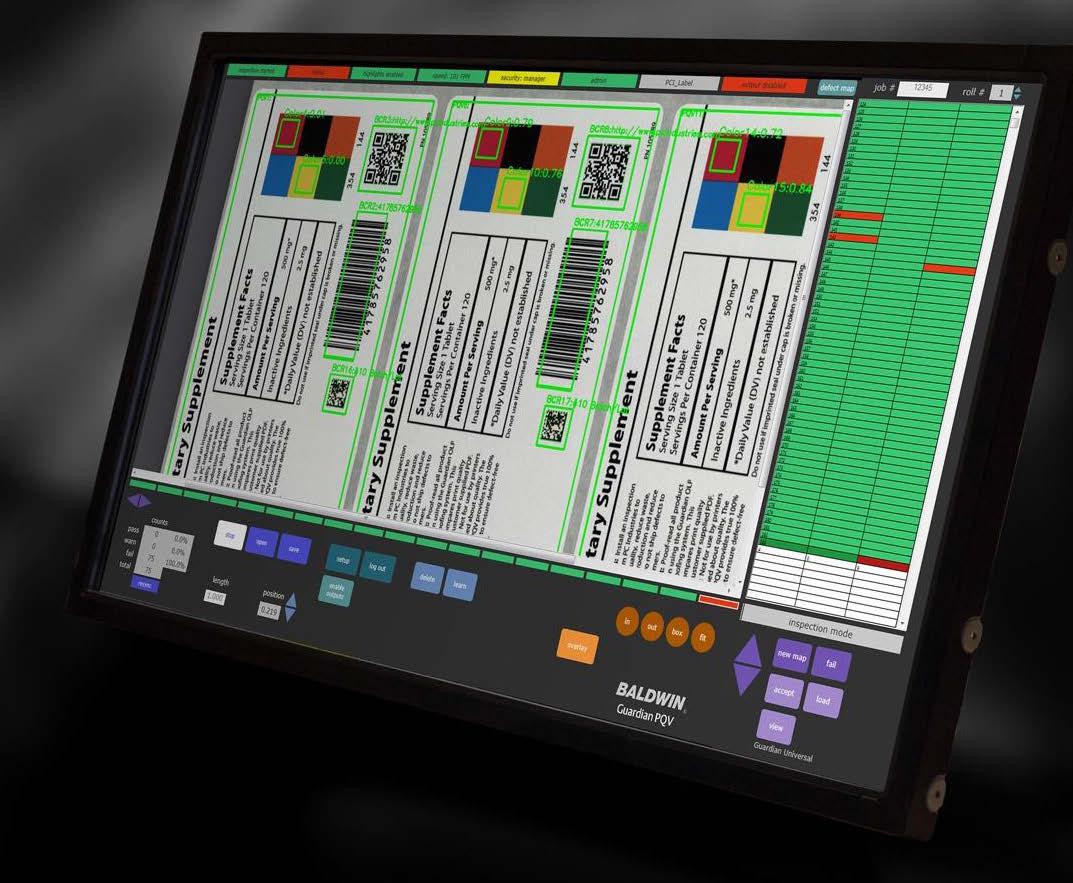
systems to identify print defects in real time. Operators use Wizard-iQ to identify individual elements of the design, from text to barcodes, within seconds. The system then monitors for print defects and color shifts throughout the print run, ensuring consistency with a micrometer level of precision throughout the run and alerting operators to any issues.

While not a common practice in offset printing, storing and reusing plates is more common in flexographic printing for packaging applications. Reusing plates is more sustainable and reduces the plate costs for repeat work. To reuse the flexo plates, they must be cleaned, dried and properly stored, which traditionally required significant labor in addition to cleaning solution and consumables.
The FlexoCleanerBrush from Baldwin improves the cost dynamics for flexo plate reuse by minimizing the time and costs associated with cleaning and
drying. The system can clean and dry every plate in each printing unit of the flexo press in under four minutes. Cleaning can also be done at the start of the print run or at intervals during the run to assist press operators with removing hickeys or when running high-pigment inks. A clean plate during the print run minimizes print defects and minimizes waste. The system allows flexo printers to extend the plate life and get more from their materials.
The printing industry may not be able to control the overall economic conditions or the supply of labor and materials. However, print service providers can get more from their operations through smart process automation that optimizes material usage, streamlines print processes, and empowers the most valuable resource — their employees.
Learn more about how process automation can improve the economics of your print operation at https://printenomics.com/.
Sponsored Content

Labels are a large and growing market for inkjet presses with more than 25 suppliers serving the market. The Buyer’s Guide for label presses
Inkjet label presses come in different sizes and from a raft of different vendors, making selecting a
Primarily in the high end of the market are found hybrid inkjet/analogue presses that can provide economic and productivity benefit over either stand-alone technology in the right scenario.
VIEW ALL THE GUIDES ON INKJETINSIGHT.cOM


 Market introduction and Entry-level presses
Mid- to high-productivity inkjet presses
Hybrid inkjet label presses
Market introduction and Entry-level presses
Mid- to high-productivity inkjet presses
Hybrid inkjet label presses
As the world leans more heavily into digitization, print service providers are on a constant quest for growth and adaptation. In the midst of these shifting sands, the labels and packaging industry has emerged as a lucrative territory. Smithers projects the global value of the print labels market to reach $41.02 billion by 2024.
A vital communication tool between the brand and its consumers, packaging provides crucial information about the product, from its ingredients or materials to its origin and usage instructions. Furthermore, labels are increasingly being used to convey a brand’s values, such as its commitment to sustainability or inclusivity.
This thriving market is energized by developments in web-to-pack e-commerce, retail packaging, sustainability, embellishments, personalization and interactive print elements like QR codes and augmented reality.

With the explosion of online shopping, the demand for packaging and labels has soared. According to the Adobe Digital Economy Index, U.S. online spending reached $73.2 billion in June 2021, marking a 76.2% year-over-year growth.
As this e-commerce train charges full steam ahead, PSPs have the opportunity to broaden their services into packaging, spawning a profitable revenue stream that meets the needs of e-commerce businesses.
A green revolution is underway in consumer behavior. One Nielsen study revealed that 73% of global consumers are willing to adjust their consumption habits to lessen their environmental impact. This new wave of environmental consciousness is fueling demand for eco-friendly, recyclable and compostable packaging.
PSPs that ride this wave by offering sustainable packaging solutions will draw in a fresh client base and tap into an additional revenue stream.
As brands vie for consumer attention, embellishments and personalization in label and packaging design have emerged as potent differentiators.
The Deloitte Consumer Review: “Made-to-Order: The Rise of Mass Personalization,” uncovers that one in five consumers is willing to pay a 20% premium for hyper-personalized products or services.
Harnessing this insight, PSPs can offer customizable label and packaging solutions, empowering clients to create unique, premium packaging that captivates buyers.
The advent of interactive elements such as QR codes and AR in labels and packaging has bridged the gap between physical and digital realms. These technologies not only provide an enriched and immersive user experience, but also deepen brand engagement. For example, a QR code on a wine bottle can guide the customer to a website containing tasting notes, pairing suggestions or a video tour of the vineyard.
In the pursuit of universal design in labels and packaging, Cy.R.U.S (Cyrus Tactile Reading System) emerges as a game-changer. As the first and only modern tactile language system, Cy.R.U.S uses raised symbols to cater to the over 2.2 billion individuals worldwide grappling with some degree of vision loss.
This system has a profound impact on independence, product safety and overall enjoyment of consumer products for visually impaired individuals.
Brands implementing Cy.R.U.S on their packaging send a powerful message demonstrating their commitment to serve all consumers equally. This innovation presents printers with an untapped opportunity to offer more comprehensive and inclusive label and packaging solutions.
Various industries exhibit unique demands for labels and packaging, paving a rainbow of opportunities for PSPs. The food and beverage industry, for instance, requires labels for nutritional details and branding, while the pharmaceutical industry uses labels to convey crucial drug information and safety instructions. The beauty and personal care industry often resorts to eye-catching packaging as a crucial differentiator in a congested market, utilizing personalization and embellishments.
Within every sector, there is a consistent need for high-quality, functional and visually-pleasing labels and packaging. This offers a myriad of avenues for PSPs to diversify their services and grow their revenue.
When it comes to serving regulated industries, PSPs must familiarize themselves with a wide range of certifications.
In the food and beverage sector, for instance, certifications such as Safe Quality Food (SQF), International Featured Standards (IFS), and British Retail Consortium (BRC) are pivotal. These globally recognized food safety certifications emphasize the systematic application of food safety procedures at each step of the manufacturing process.
In addition, PSPs catering to the organic food market need to understand the certification processes under the USDA’s National Organic Program (NOP) in the U.S., or the Organic Products Regulations under the Canadian Organic Standards in Canada.
In the realm of pharmaceuticals and nutritional supplements, the Current Good Manufacturing Practices (cGMP) are enforced by the FDA in the U.S. and by Health Canada in Canada. These regulations ensure that products meet specific standards for identity, strength, quality and purity.
Furthermore, the globally recognized ISO 9001 Quality Management System (QMS) certification can be a key differentiator for PSPs, demonstrating their commitment to consistently providing products that meet customer and regulatory requirements.
Obtaining these certifications not only ensures regulatory compliance but also strengthens a PSP’s market position. It is a testament to their commitment to safety, quality and continuous improvement, fostering greater trust among clients and paving the way for new opportunities in regulated industries.

The choice between digital and traditional methods like flexography (flexo) or offset isn’t a one-sizefits-all proposition. Each technology caters to a distinct set of customer needs and business models.
Small- to medium-sized enterprises, startups and companies with an assortment of SKUs or frequently changing designs, often lean towards digital printing. This technology enables rapid turnarounds, lower costs for short runs, and simple design modifications, ticking all the right boxes for these businesses. Moreover, the ability to personalize and modify labels without incurring extra costs bolsters the popularity of digital printing.
Conversely, larger corporations with high-volume, static print jobs often opt for flexo or offset
tency and quality. Consequently, companies with high-volume needs that don’t require frequent design alterations find considerable value in these traditional methods.
The rising trend of hybrid printing systems, which blend flexo and digital capabilities, is blurring these distinctions and offering enhanced flexibility and efficiency in label and packaging production.
The labels and packaging industry is buzzing with trends that spell a world of opportunities for PSPs, having evolved from a mere necessity to an integral part of the marketing and branding strategy. Today, they play a pivotal role in creating a
packagingThelabelsandindustryis buzzingwithtrends thatopenaworldof opportunities.
A WhatTheyThink LunchNLearn Webinar
Wednesday, November 1 @ 1 p.m. ET
Join WhatTheyThink’s David Zwang as he highlights the latest technology trends in label and packaging solutions. This session will detail how shifting market requirements are driving new innovations from label and packaging printing and converting equipment manufacturers.
Also get the latest new product announcements from such recent shows as LabelExpo Europe and PRINTING United.
Labels and Packaging: Outside the Box

Register here!
If you can’t make it live, register to receive the replay.
Sponsored by

Embellishments are as old as print. The first printed book, the Bible printed by Gutenberg, contained illuminated letters and ornaments in gold or colored ink. Today we might call it metallics and spot colors.
Gutenberg decided that the letter at the beginning of each book should be illuminated separately. An empty area on the printed sheet contained only a small letter to indicate which letter the illuminator should draw in large format. The letter could be festively and colorfully decorated - depending on the client’s wallet and taste.


Already in this earliest case of enhanced print some common topics of print embellishments prevailed.
Embellishments make a print product more desirable. The amount of embellishments should match the wallet of the recipient. Producing embellishments can require a lot of effort.
What an embellishment exactly is, is often in the eye of the beholder. Generally, it provides additional visual or tactile effects beyond what can be achieved by standard process color printing.
Some effects are more effective or striking than others and tend to have a higher value to the end customer. There are seemingly endless variations possible in using embellishing effects in combinations with each other or with process color print. Some combinations, like specialty colors and spot coating, work especially well.
Spot colors have the longest tradition as embellishments. When printing was much more of a craft than a highly automated industry, mixing and exchanging inks used to be less of a hassle and drag on profitability than it is now.
A sign of how disconnected production print became from mixing colors on site are the developments at Pantone, still the most widely recognized system to specify spot colors. The colorful sample booklets are actually not the standard anymore, the spectral values are. The booklets only illustrate the outcome. Some of the latest Pantone color recipes are even too difficult to mix repeatedly and uniformly as they require blending grams of some base inks into a kilo of ink.
The alternative is emulating spot colors with extended gamut ink sets, although a few spot colors might still be out of the gamut and hitting the right color requires more skills. Improvements in color management and process control are mak-
ing this easier now. The savings potential compared to mixed colors are considerable.

A Finnish study from 2021 did calculate the savings potential for a flexo press moving from mixed inks to a seven-color extended gamut set. According to the study, an improvement in the OEE of 42% to 85% and a total cost savings of around 6 to 1.3 million euros per printing press per year has been calculated. In addition, the CO2 equivalent is reduced by 34% to 51% compared to spot color printing.
While pure spot colors are on the decline, special effect color usage is on the rise, driven by the desire to stand out, coupled with easier handling and

wider availability of the effect inks. Printed metallics provide an effect that cannot be achieved by process colorprint. The resemblance to precious metals naturally conveys a message of intrinsic value, which can be of benefit to a wide range of print products.
In contrast, fluorescent seems to be more limited in its use. Obviously, warning signs, book titles or some flyers can benefit. So far there is limited uptake in corporate colors for fluorescent. This is slowly changing, however, as younger, start-up companies use the effect to stand out. This is spilling over into more established companies, looking for a facelift.
An interesting, recent example is the venerable German printing association (BVDM) moving to a bright, almost fluorescing, orange as new corporate color. Another interesting use is mixing fluorescent with process colors. The combination works almost as a gamut extension, giving some colors more pop.
Foiling is typically used for metallic effects and feels like printed metallics on steroids. The visual impact is high, but the big downside is that the process is more complicated and wasteful, and accordingly more expensive. It is a balancing act to justify the extra expenses for the high visual impact.
The Ecoleaf technology from Actego is coming to the market now and strikes a compromise between metallics and foiling. It uses a printed trigger image and special metallic flakes, avoiding lots of foiling waste material. The effect is much stronger than metallic inks, getting close to foiling. An added bonus is that the technology can produce metallic gradients.

Coatings and varnishes are a special case – they can have mechanical or embellishing features. They can protect a print from rough handling at the end user place (e.g. a printed menu) or in finishing (rollers in mailing lines). Likewise, gloss or matte coating can make a print more prominent, and spot coating has seen a rise in use. Given the relatively low price of the materials, using a coating can be quite cost-effective.

Although in the market for several years, textured and tactile surfaces still surprise and captivate many customers. As an image overlay, the effect can be stunning. Surveys show that print buyers are willing to pay a higher premium for textured effects than for any other. Accordingly, the uptake is rising quickly, but from a low base level.

Embellishments came a long way since Gutenberg’s times. Very rarely manual work is still involved. Most of the effects can be produced inline in the printing press. This is generally the most efficient way of producing enhancements. Foiling and textured effects are the big exception and while in-line solutions exist, usually these effects are applied offline.
Spot or speciality colors are generally easy to produce on analog presses, provided the press has extra print units. Changing inks on a press does produce waste and downtime, however, making the effects less efficient for short runs and frequent changes. With increasing interest in short runs and on-demand production, volumes are moving to digital print, however, where add-
ing speciality colors is more complicated. A digital printer does not only require extra imaging units beyond the process color slots, the supplier also needs to offer certain speciality inks or toners as well. Even with the extra imaging units the choice of effects is limited accordingly.

Metallics are getting increasing traction in digital print, with HP Indigo, Kodak, Fujifilm and Xerox being the frontrunners. Still, the choice of presses is limited. White is widespread in digital label and packaging presses, with some models offering gamut enhancements as well.
Textured effects are typically applied offline, as the change-over and running characteristics of the embossing equipment can differ from the printing press. The inkjet devices creating textured effects from the likes of MGI, Duplo, Scodix and Steinemann can require multiple passes, slowing down the throughput and making it somewhat unpredictable. Still, those printers allow for striking effects in short runs. For a more muted tactile effect, inline features can be used as well, for example, clear toner on toner presses or white ink on UV-printers.

There are more markets for embellishments than commercial and packaging print. A number of wide-format printers offer light cyan/magenta for smoother gradations or gamut-enhancing ink/ toner channels. However, there are more.
Roland DG bought a controlling stake in Dimense, a specialist for digital embossing and embellishment technology for large format prints. The Dimense printers run water-based latex inks and proprietary clear structural ink. Glittering effects are possible as well.
The plan is to expand its role in driving the development of digital wallpaper production. The technology also opens up applications in calendars, event graphics, packaging, point-of-sale and roll-up banners. Avoiding an embossing cylinder makes small batches possible and new designs easy and quick to produce and test.
Being able to produce embellishments is not limited to hardware however. Special software for proofing and color management, like from ColorLogic, is needed as well, to handle files effectively. Displaying the effects in a web-to-print applications needs to be considered as well.
The big question remains: how interested are print buyers in embellished prints and how much of a premium are they willing to pay? Given the range of embellishing options, print products and customer types, there is no easy answer.
Research shows that customers are interested in embellishment effects - if they know about them. A recent survey from digital embellishment experts and consultants from Taktiful and WhatTheyThink.com looked into uptake and challenges among digital press users. There is good interest among buyers, with 30% either extremely or very interested and another 45% being somewhat interested. With more market education I believe these shares could even be higher, as few print buyers are familiar with the breadth of embellishment effects possible.
This is somewhat reflected in how users of embellishment-capable digital presses are satisfied with sales and profitability. Almost half of the survey respondents are satisfied with the sales, while the other half are neutral or dissatisfied. The profit picture looks undoubtedly better, with

more than half of the users satisfied and only a minority being dissatisfied. Quizzed further, more than one-fourth of survey respondents (26%) said that specialty ink and toner jobs were “always” more profitable than regular CMYK jobs.
In my experience, a lot of challenges lie in market education and active marketing of special effects. Many effects require a show-me approach, with print samples being especially effective. The enhancements being difficult to show on a screen does not help either, with fewer traditional print buyers and more multi-media buyers, typically being less familiar with print. Finding the right customer and application combination can be a challenge as well – some might not be interested in an effect, while others are willing to pay a decent premium.
Embellishments can be a growth path for sales and profitability. In competition with electronic media, print became a premium channel. Embellishments encompass what digital channels cannot, eye-catching visual effects and tactile properties that attract attention.





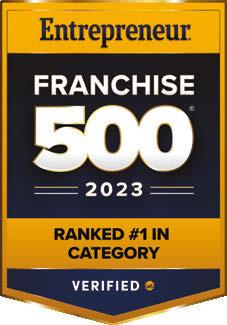


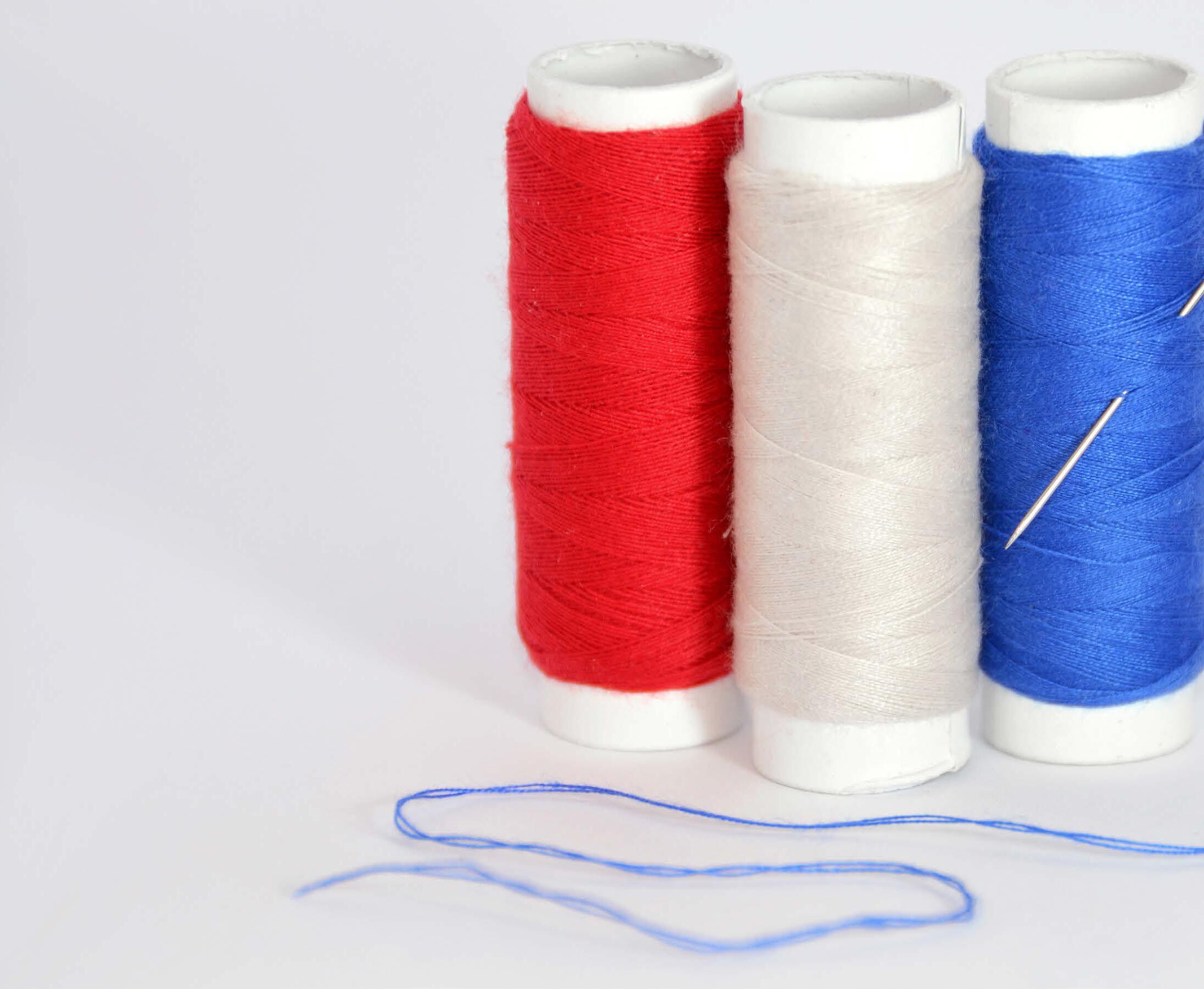 By Cary Sherburne
By Cary Sherburne
The COVID pandemic laid bare the frailties of the global supply chain. There was much discussion in the textiles and apparel industry about how to mitigate the issues experienced when shipping product from Asia, including excessive costs, which have recently normalized to pre-pandemic levels. This included more consideration of reshoring— or nearshoring to Latin America.
However, is reshoring a reality? Experts are not totally in agreement that it is, or that it will happen at scale. What we are seeing is pockets of reshoring, some successful operations, but no adoption at any grand scale as of yet.
“What happened during the pandemic really changed the minds of many people in the U.S.,” said Amy Bircher, board chair of the U.S.-based Advanced Textiles Association (formerly the Industrial Fabrics Association International). “When communities couldn’t even get PPE to protect their frontline workers and were relying on imports which were suddenly unavailable, the response was on a personal and emotional level.
“As a result of that experience, a significant number of U.S. companies have now decided that no matter how painful it is, they will not be held hostage to that purchasing model again. “There remains a determination by many to create opportunities and new jobs in the USA or in neighboring countries in Mexico and Central America.”
So yes, the desire is there, and we are seeing some action. But is it enough?
According to “The Sourcing Journal,” Deloitte estimated in November that American companies were expected to reshore 350,000 jobs in 2022. According to the Reshoring Initiative Data Report, that expectation was actually exceeded, with some 360,000 reshored jobs reported, a 53% increase over the 2021 record.
This was attributable to a huge surge in onshore manufacturing of electric vehicle batteries and chips along with a broad range of other indus-
tries. Electrical equipment appliances and components accounted for nearly 152,000 of those jobs, while apparel and textiles ranked sixth, with only 10,674 reshored jobs. That’s about 3% of the reshored jobs. Surely we can do better than that.
For the apparel industry in particular, some experts believe the benefits of making such a move could far outweigh the costs of relocating production from Asia.
“Much of the strength of the reshoring trend has been due to more companies becoming familiar with a broad range of factors (costs and risks) they had previously ignored,” according to “The Reshoring Initiative” report. That means looking not specifically at the cost of individual components, such as labor costs; but rather, taking a total cost of ownership (TCO) approach.
“The impact of using TCO shows that shifting decisions from a price basis to TCO can be expected to drive reshoring of 20% to 30% of what is now imported,” according to the report. “In Exhibit 3c [of the report], the percentage of work that is more profitably sourced domestically rather than imported from China rises from 8% to 32% when the sourcing metric shifts from FOB price to TCO. The reshore-able percentage rises to 46% if a 15% Section 301 tariff applies.”
Earlier this year, Congress began considering a bill that uses tariffs on China-made goods to provide tax incentives for companies to bring manufacturing back home, which could significantly increase the re-shorable percentage. One would think that bill would have bipartisan support in both houses of Congress, but nothing is ever certain in today’s divisive political environment.
Another Congressional bill in progress is the FABRIC Act. If it is passed, it could also help drive manufacturing back home. It is designed to introduce new workplace protections and manufacturing incentives “to cement the U.S. as the global leader in responsible apparel production.”
One element of the proposed legislation is the establishment of a nationwide garment industry registry. This is designed to promote transparency, hold bad actors accountable, and level the playing field. There is more garment manufacturing in the U.S. than you might think, but it is fragmented. In the sewn products industry, SPESA is attempting to map where cut-and-sew operations are already located in the U.S., a task that is proving formidable.

A recent article reflected that there are about 45,000 garment workers in LA, for example; but trying to map cut-and-sew a little further south, in San Diego, has proven to be quite difficult, according to SPESA.
In terms of nearshoring in Latin America, many American companies already avail themselves of the talent, capabilities and lower labor costs in countries like Mexico, Peru, Colombia and Brazil. Experts say that sourcing from Latin America cuts lead times by about a third, compared to sourcing from Asia. And in many of those countries, labor is actually less costly than Asian labor.
According to John Hyatt, founding partner of The Mexico Strategic Sourcing Alliance, brands must consider cultural differences between North and South America when attempting to establish a shorter supply chain.
“Latin America has a risk-averse business culture,” Hyatt said. “If they do not know you and like you and meet you in person, they will not work with you. They are a relationship-based culture. Something that may take one or two on-site visits in the United States will take at least two or three in Latin America. Final concessions are always done in person and usually over meals.”
But these efforts don’t mean that everything will leave Asia. It just means that brands set themselves up to have a more flexible and diverse supply chain with different options in case there are future issues, or if they need faster delivery on some products, or are looking for smaller minimum order quantities.
In addition to the need to build the appropriate relationships for nearshoring, reshoring also has its barriers. Increased automation is one advantage that many companies in the U.S. will have—all the way up to the sewing stage, where automation still lags.
Digital fabric printing, direct-to-garment (DTG), and direct-to-film (DTF) technologies will help make on-shore manufacturing more efficient. However, the lack of sewing talent is still an issue.
There are pockets of success. Sparta Mills, in North Carolina, has a waiting list of sewists looking for employment. Kirby Best’s BMC.fashion, in Phoenix, has had great success in hiring sewists as well—40% of whom are men.
However, these are just examples of pockets of cut-and-sew successes.
Best also implemented a training mechanism. He claims that a sewist can become competent in one seam type a day, and over time can add more seams to their portfolio, enabling new workers to be productive quickly.
Another barrier is the perception of the industry—a hangover from the old days when sweatshop conditions prevailed. The industry is much different today—or can be—and we need to educate students and their parents about the opportunities the industry can provide: high-tech, rewarding careers.
It also goes without saying that reshoring and nearshoring have environmental benefits.
“Ships are responsible for annually emitting more than one billion tons of CO2 and greenhouse gases, an estimate which is projected to increase by a value somewhere in between 50% and 250% by the year 2050,” according to a white paper published by the Reshoring Institute in 2020. “To put this in perspective, if international shipping was treated as a country, it would have been the sixth largest emitter of energy-related CO2 in 2015.”
Adopting more on-demand production, such as that being done by BMC.fashion and Spoon-
flower, results in less waste, reduced inventory risk and the ability for brands and consumers to more easily customize apparel and other textile-based products, adding value and likely increasing retention rates.
“A new reshoring trend is set to upend global supply chains [in 2023 and beyond] as firms look to source products—such as clothes and computer chips—closer to home, turning away from manufacturing powerhouses like China,” according to a CNBC article.
The report notes that in S&P 500 earnings transcripts, mention of reshoring was up 128% in the first quarter of 2023, compared to the same quarter the previous year. And some industry veterans are suggesting that the current supply chain model should be destroyed.
“As the industry continues to grapple with its damaging environmental and social impact, consumers, regulators and other stakeholders may increasingly scrutinize how brands communicate about their sustainability credentials,” according to the McKinsey “State of Fashion 2023” report. “If brands are to avoid greenwashing, they must show that they are making meaningful and credible changes while abiding by emerging regulatory requirements.…79% of fashion executives [surveyed by McKinsey] consider the lack of standards to assess sustainability performance as the greatest hurdle to improving how consumers perceive their sustainability efforts.”
Reshoring, nearshoring and production on-demand at or near the point of need, will be an important part of this progress.
So where do we go from here? It’s important for the industry to showcase successful reshoring efforts, including metrics that demonstrate a clear, lower, TCO. This will be especially helpful if the case studies include major brands. It’s often the case that once one or two major brands adopt
In addition to the need to build the appropriate relationships for nearshoring, reshoring also has its barriers.
a significant change and demonstrate the financial benefits of that change, others will follow.
It is also a fact that more often than not, what one might call “upstarts” enter the market and upend traditional processes. That’s what happened in the book printing industry, where a substantial portion of book printing is now digital and on demand. There is no reason this same trend could not be applied in the fashion industry, especially considering all of the digital technologies that are now available to shorten design cycles, deliver more collections per year, streamline product development via 3D imaging and enable end-user customizations.
As consumers, it is also critical that we demand of our favorite brands that they take fast and demonstrable steps toward a more sustainable manufacturing process. Especially as the more environmentally conscious younger generations are likely to abandon brands that do not act responsibly as the climate crisis continues to
accelerate. Those generations will soon comprise the bulk of fashion and home décor buying, if they are not already doing so.
Reshoring and nearshoring are important elements of improving sustainability. Plus, it is more likely that the well-being of workers in the fashion and textiles industry will be monitored more closely when manufacturing is brought back home, that might be possible in some Asian countries.
We will continue to monitor these phenomena, including reshoring, nearshoring, implementation of an increased level of digital technology and automation, and efforts to grow our sewing skills back to what they had been in the past.
We’re hoping that joining others in shining a light on the current conditions in fashion and apparel, and the textiles industry as a whole, will help to accelerate the necessary change for a more sustainable future—for the industry and for the planet.

Adopting more on-demand production, such as that being done by BMC.fashion and Spoonflower, results in less waste, reduced inventory risk and the ability for brands and consumers to more easily customize apparel.
Sixty-one years ago filming began on the epic movie project “The Greatest Story Ever Told.” The plot was nothing less than the life of Jesus Christ.
A film of such epic proportions mandated an allstar cast, so dozens of name actors were assigned roles. Included were up-and-coming newcomers, established working actors and a few superstars.
Among those in the middle category of established working actors was Telly Savalas, who was cast as Pontius Pilate. He had made a steady career first in radio, then in television and movies, but still wasn’t a top-name star.
Savalas was not blessed with typical leading-man looks and was most often cast in supporting character roles. Now middle-aged, he had lost much of his hair to male-pattern baldness, which lead him to a momentous decision. He decided to shave his head for the role of Pilate, to give himself an authentic Roman statesman appearance.

When filming was completed, Savalas made his second momentous decision: He opted to continue shaving his head.
Here in the third decade of the 21st century a shaven head is commonplace. Not so in the 1960s. Virtually no one shaved their head. In the acting business, where getting attention is crucial, Savalas hit upon a gimmick that got his talents noticed.
From that point on, he was “the bald guy.” Any bald joke mentioned Telly Savalas. Mention a bald actor, and everyone immediately knew to whom you were referring.
Savalas was never again out of the public eye, and more importantly, never without work.
Savalas has been gone for three decades, but today he is visiting Johnson’s World to teach us all some important lessons. No matter how much or how little hair you have, you can learn a thing or two from his experience.
It pays to stand out. You may be good at what you do, but so are many others. Having an angle, a hook, a gimmick may be just what you need to get yourself or your company noticed.
It pays to specialize. In the movies, everyone is beautiful. In business, everyone has quality, service and price. A niche can set you apart from the competition.
You don’t need to be the first. Yul Brynner had been successfully plying the shaven-head look in Hollywood for a decade when Savalas joined him in sporting a bald hairdo. There is always room for two.
You better be one of the first. I don’t remember who the third shaven-headed actor to achieve fame was, and neither does anyone else. It isn’t unique once everyone is doing it.
A gimmick is good but it isn’t enough. Savalas was remembered for his unusual hairstyle, but was cast in leading roles for his resonant voice and commanding on-screen presence. Once you get people’s attention, you’d better have what it takes to follow through.
Take the time now to figure out ways to truly differentiate yourself in your new market, or later on you’ll be pulling your hair out in frustration.
1/2 Cup Maple Syrup
2 Cups Cranberries
Zest of 1 Orange
1 Cup Bourbon

1/2 Cup Lemon Juice
1 Cup Cranberry Juice


3-4 Dashes Orange Bitters
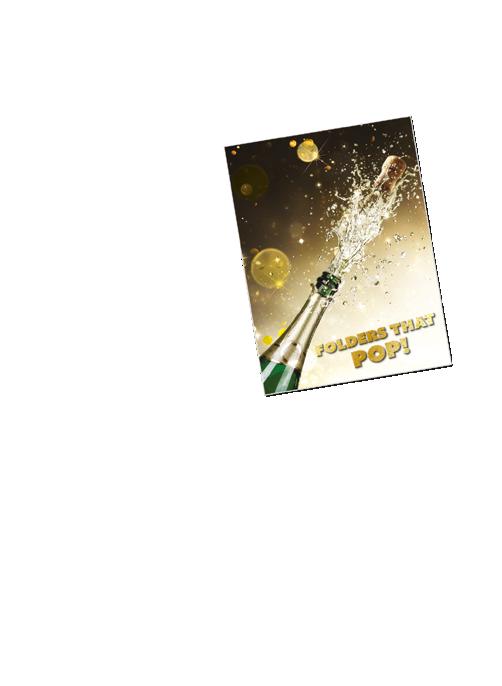

Instructions







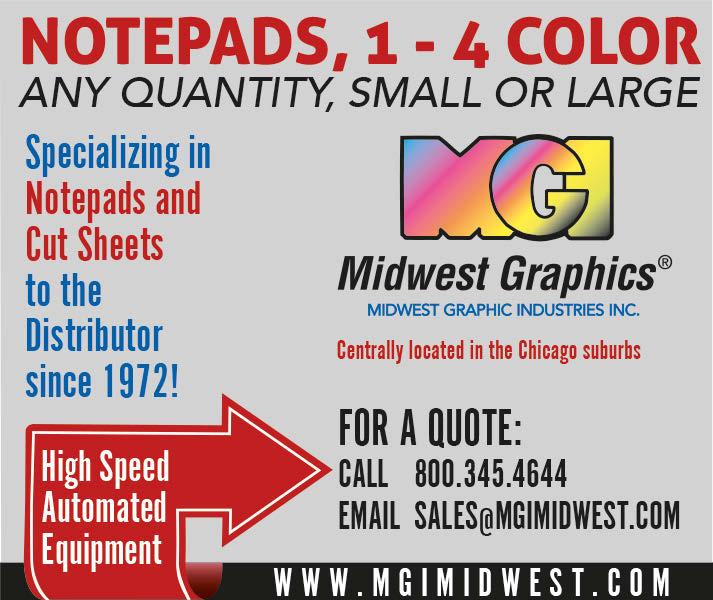


To make the cranberry syrup: In a medium pot, bring 1/2 cup water, the maple syrup and cranberries to a boil over high heat. Boil 5 minutes or until the cranberries begin to burst, then remove from the heat. Stir in the orange zest.
In a punch bowl, combine the cranberry syrup, bourbon, lemon juice, cranberry juice, and orange bitters. Stir to combine, chill until ready to serve. Serve over ice.
